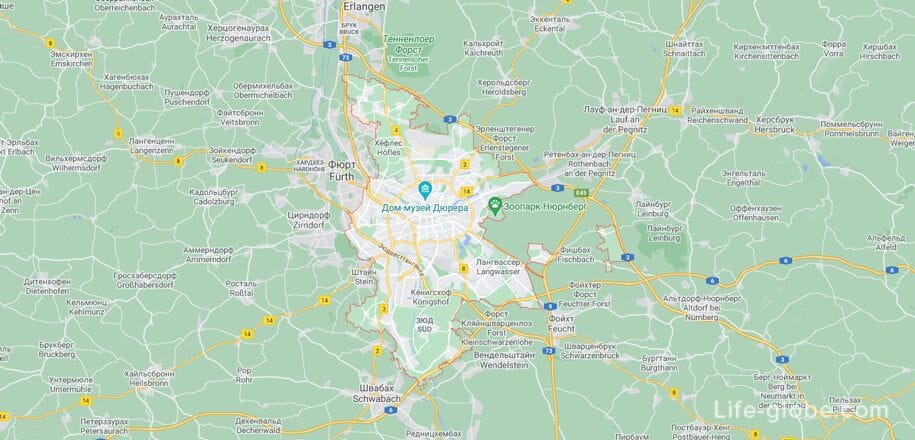Nuremberg (Nuremberg, German name: Nürnberg) is an ancient German city, which is the second largest in Bavaria, after Munich, and one of the largest in Germany.
Nuremberg is located in the region of Franconia, in the south-west of Germany.
It is known that the first traces of a Slavic settlement in the city date back to about 850, while the foundation of the first city probably dates back to the dates between 1000 and 1040. Subsequently, the city developed and expanded.
Today Nuremberg is very popular among tourists, as it is the only major city in Germany that has managed to preserve the features of medieval buildings to one degree or another. The city also has a lot of attractions and museums that reflect the centuries-old and heterogeneous history of Nuremberg. And the Christmas fairs held on Christmas Eve in the city are considered one of the most beautiful and colorful in Europe.
Nuremberg is called the most German city in the country. It is unofficially considered the pearl of Bavaria and bears the title of "Treasury of the German Empire", and its The Old Town is one of the best in Germany.

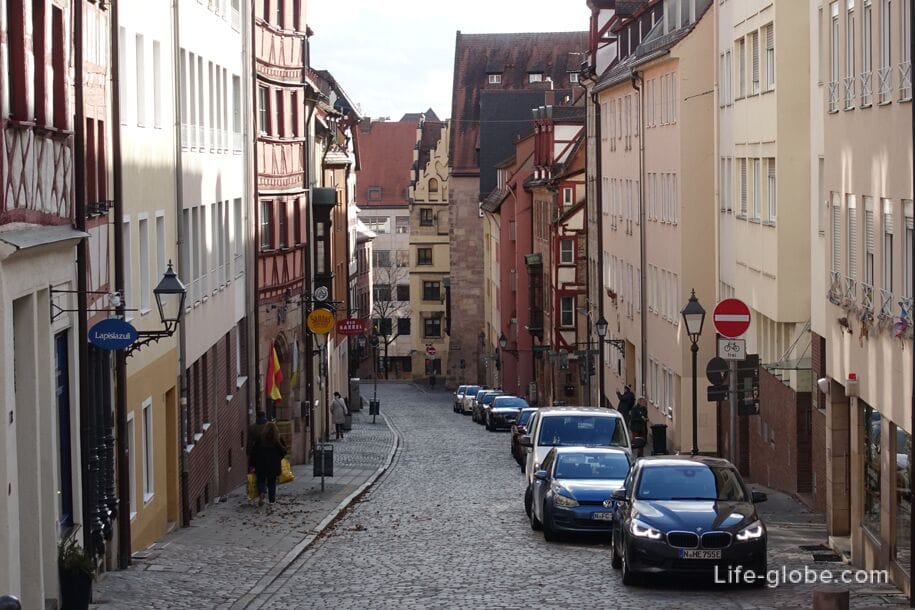
Historical Mile of Nuremberg
Although most of the historical architectural ensemble of Nuremberg was destroyed or damaged during the Second World War, nevertheless, it has now been restored and restored.
The Historical Mile of Nuremberg (Historische Meile Nürnberg) hiking route has been laid along the most significant historical sites of the city, which was created as part of the celebration of the 950th anniversary of the city of Nuremberg in 2000 and gives a brief idea of the main attractions of the medieval city. Learn more about the Historical Mile of Nuremberg...


Nuremberg's Old Town and the Pegnitz River
The Old Town of Nuremberg (Altstadt Nürnberg) is the heart of the city and the place where the main tourist life takes place.
Nuremberg's main attractions are located in the old town and there are historical architectural monuments, including a fortress on a rock, half-timbered houses, elegant fountains, Gothic churches, town halls, museums and medieval dungeons, which are guided tours. And the city itself is almost completely surrounded by a former fortress wall with fortifications.
Also, the old city of Nuremberg is distinguished by paved streets, some of which are pedestrian; small but cozy squares; an abundance of cafes, bars and restaurants, there are taverns and summer beer gardens; souvenir shops, shops and small shopping centers. Accommodation facilities (hotels, apartments) are also located in the old town
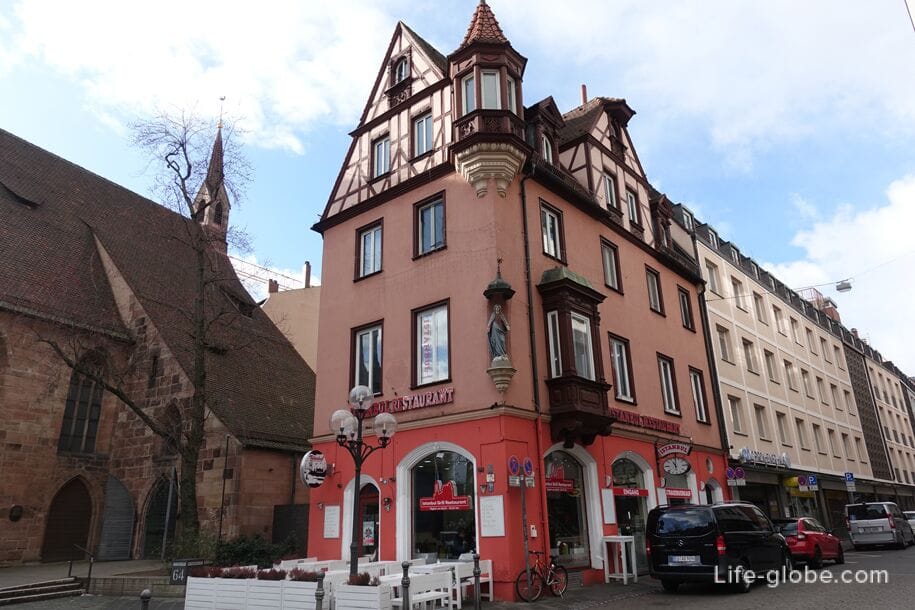

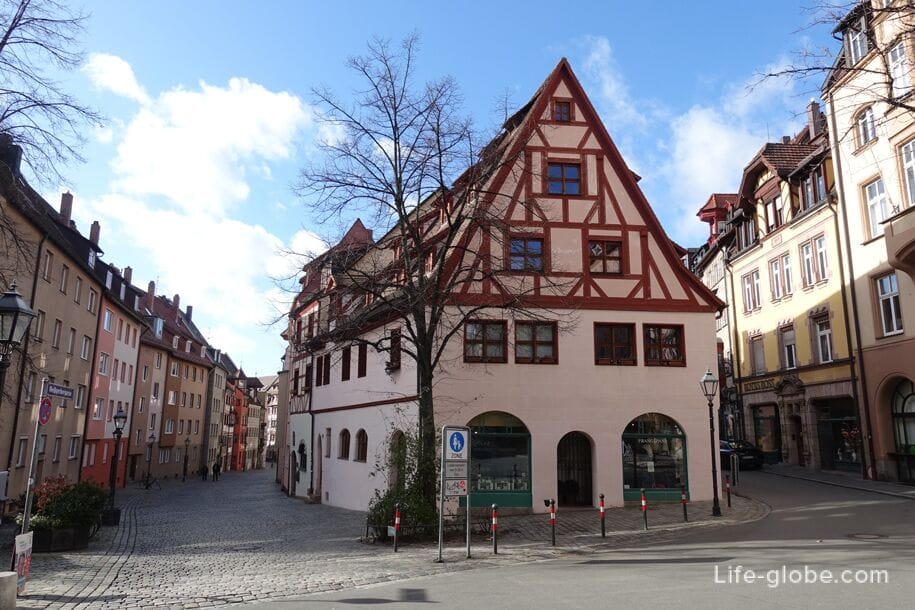
The last city wall with fortifications surrounding the current old city of Nuremberg was built by 1400 and had a length of 5 kilometers.
Today, the fortress wall of Nuremberg is one of the most important artistic and architectural monuments in the city. There are gates and towers in the wall, some of which are used by organizations and individuals. Behind, on and in front of the wall, as well as in the moat that has been preserved in places, now there are mainly pedestrian paths available for public use, and the moat itself is largely designed as a park. The former bastions to the west and north of Nuremberg Castle are arranged as a castle garden and are usually accessible during the warmer months. Learn more about the Nuremberg wall and fortifications...
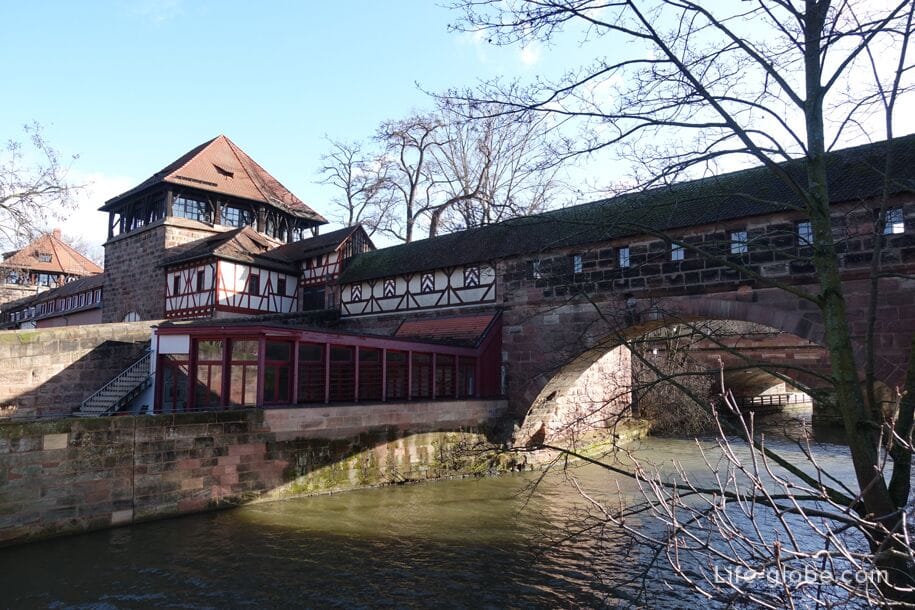
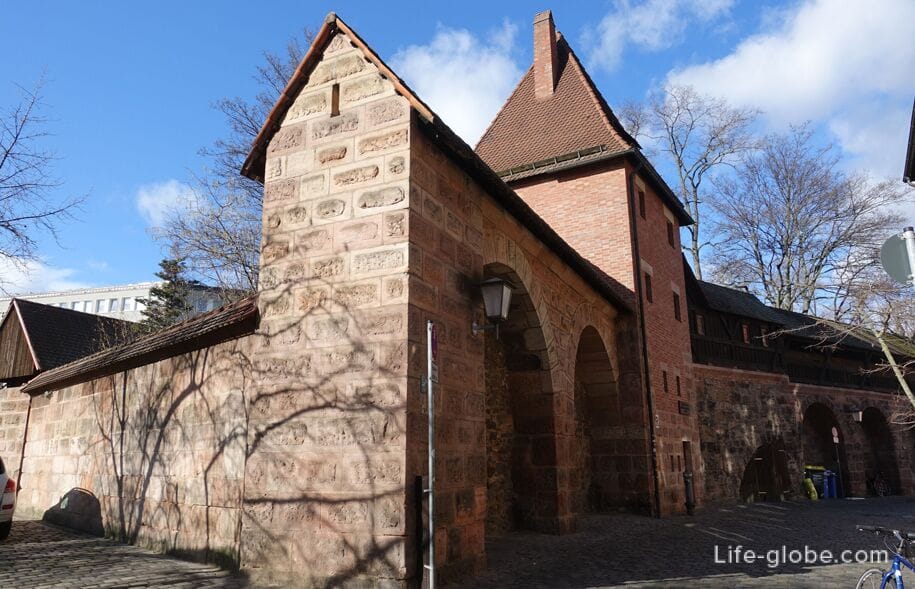
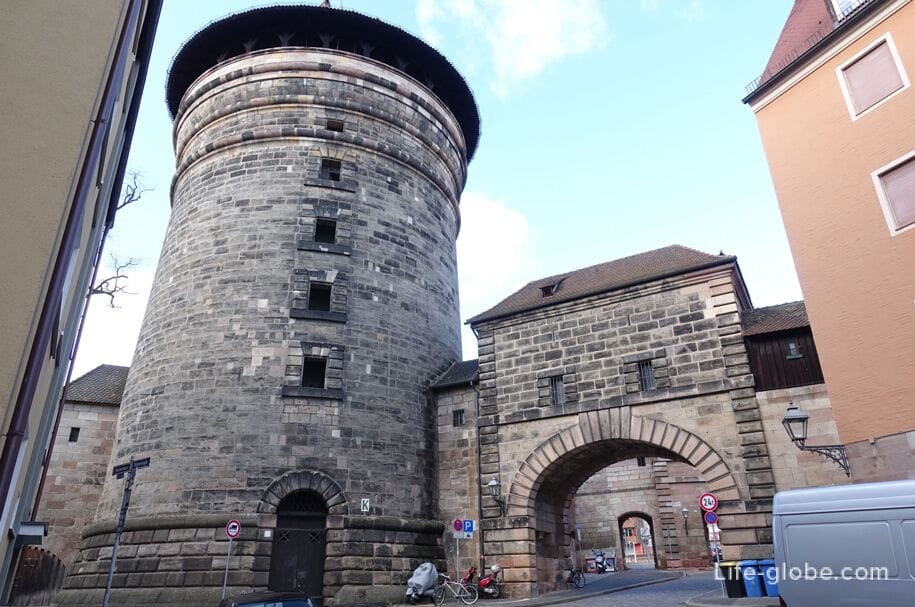
The Pegnitz River, which is the city river of Nuremberg and flows through the entire city, flows in the historical center of Nuremberg and divides the old town into two halves of almost the same size: the north Sebald (Altstadt - Sankt Sebald) and the south Lorenz (Altstadt - Sankt Lorenz).
Embankments run along the river in the old town, historical buildings are located, and the river itself is crossed by bridges that have been part of the urban landscape since the Middle Ages.
Of the most significant bridges over the Pegnitz, one can distinguish: Museum Bridge (Museumsbrücke), Meat bridge with a Bull portal (Fleischbrücke), Hangman's Bridge (Henkersteg) and Chain Bridge (Kettensteg). Learn more about the bridges and embankments of the Pegnitz River in the old town of Nuremberg...
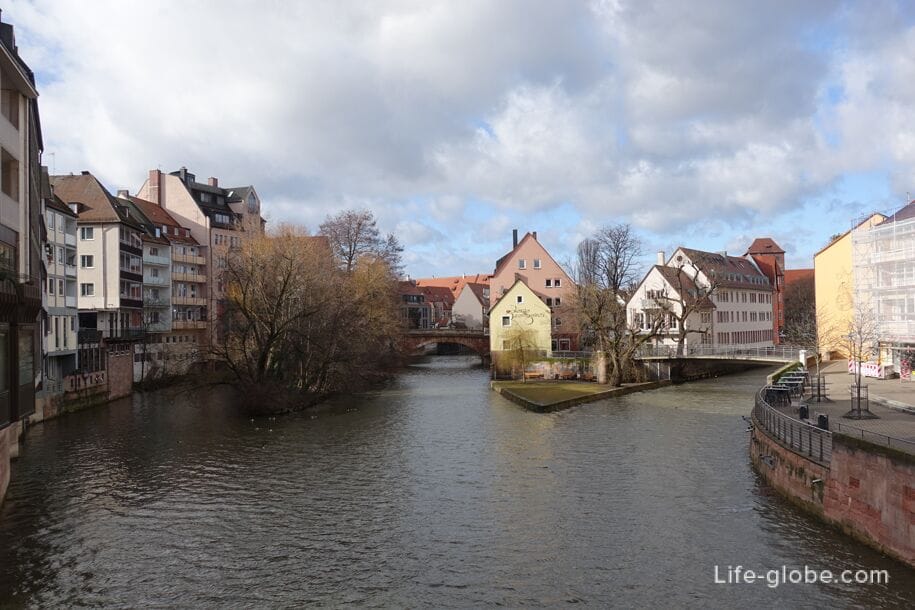
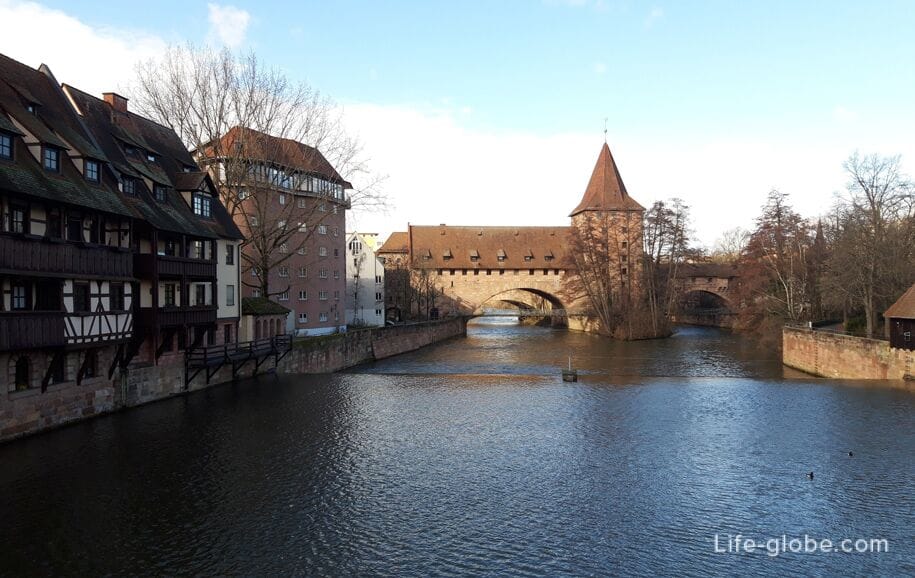
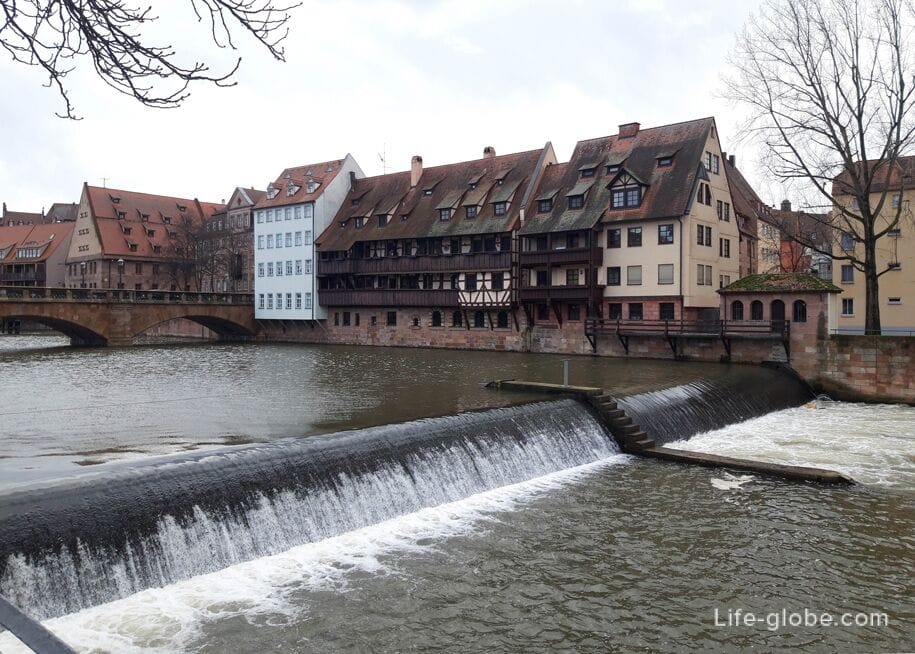
The main square of the Old Town and the whole of Nuremberg isThe market square (Hauptmarkt), which is almost entirely the pedestrian center of the city and a place where something is constantly happening - whether it's the weekly market or the main Christmas market of the city. More about the Market Square...
On the Market Square are notable:
- A beautiful fountain or a Beautiful fountain (Schöner Brunnen / Schoener Brunnen), built between 1385 and 1396 from sandstone.
Today on the Market Square there is a colorfully painted copy of the shell-stone fountain (1903). More about the Beautiful Fountain...
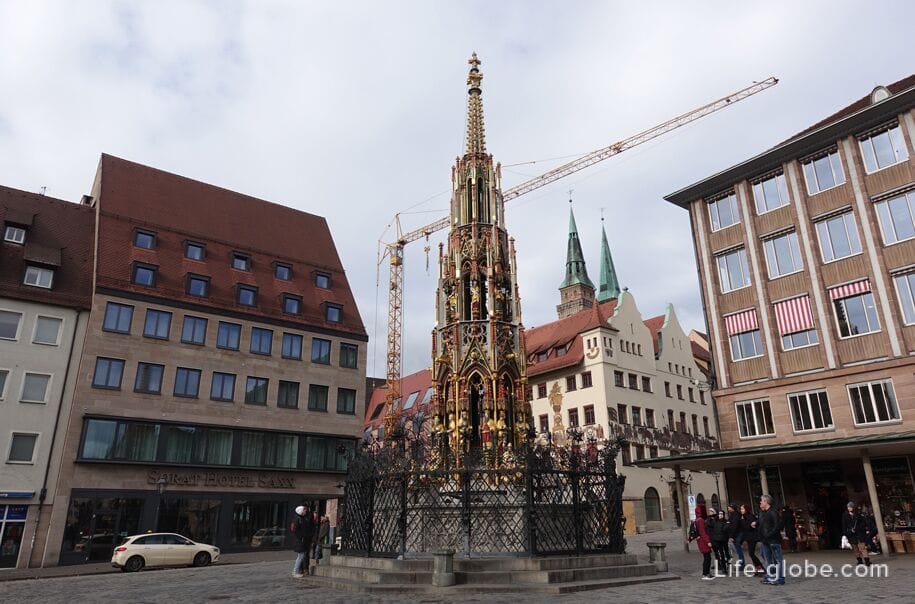
- The Church of the Virgin Mary or Frauenkirche, which is the main dominant of the square and was built as an imperial court chapel and a hall church building from 1352 to 1362 on the initiative of Emperor Charles IV. More about the Frauenkirche...


- the ensemble of Nuremberg Town Halls, consisting of the Old Town Hall and the New Town Hall.
The Old Town Hall (Altes Rathaus) consists of two parts: the oldest part of the town hall - Gothic, built since the 14th century (between 1332 and 1340), and later, made in the style of the Italian Renaissance - built in the 17th century.
In the basements of the Old Town Hall there is a museum of medieval dungeons (Mittelalterliche Lochgefängnisse), which consists of a historical dungeon prison, the cells of which have been used since the 14th century for interrogations and detention of prisoners before the execution of sentences.
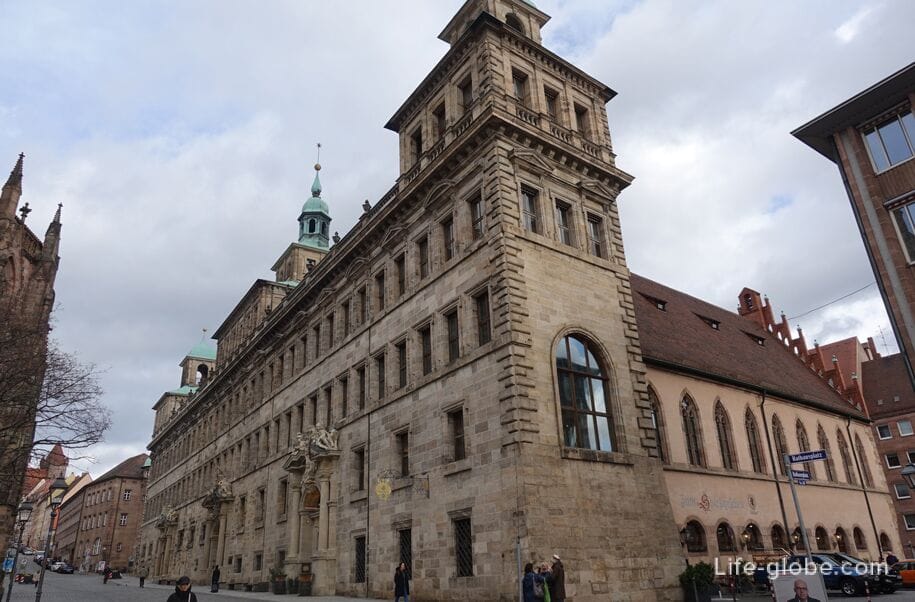
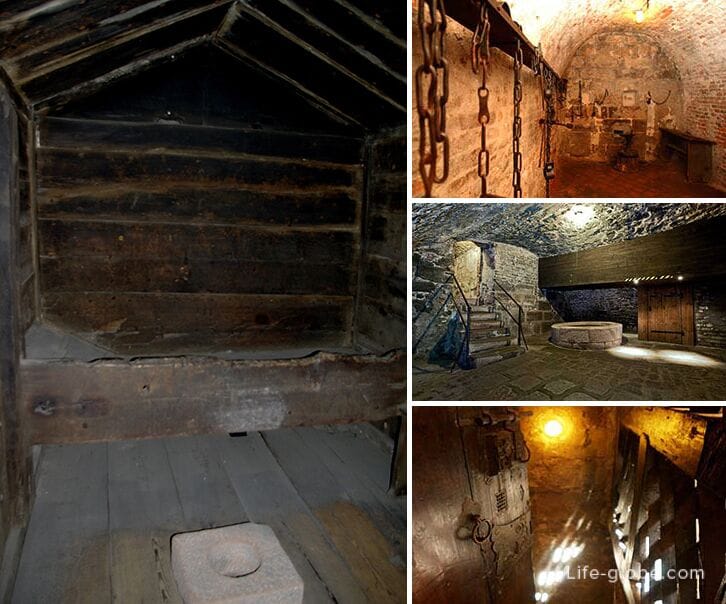
The New Town Hall (Neues Rathaus) is a detached building located on the south side of the Old Town Hall.
The construction of the town hall took place from 1954 to 1956. More about the town halls and the prison museum...
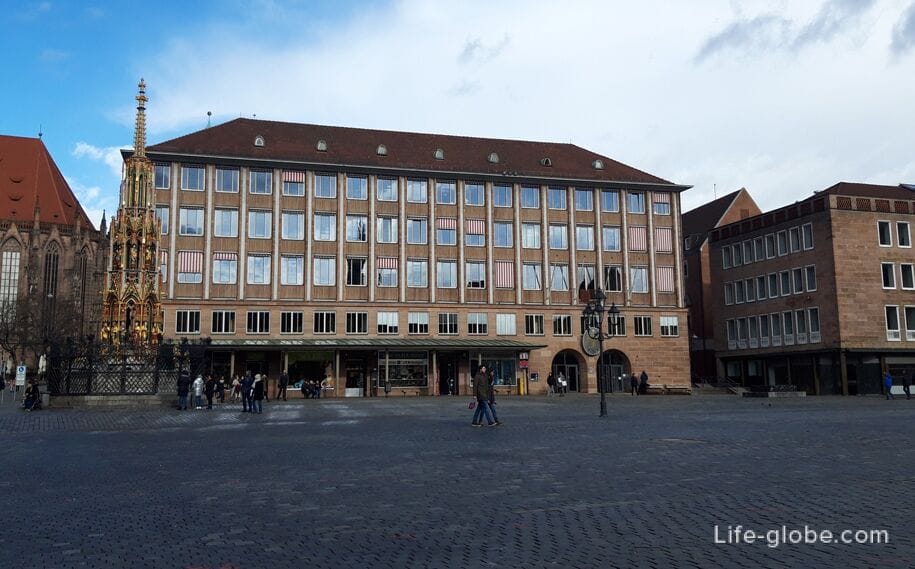
Other main attractions of the old city of Nuremberg include
Nuremberg Fortress (Nürnberger Burg), also known as Kaiserburg Castle (Kaiserburg Nürnberg) - the former residence of the rulers.
Today, the Nuremberg Fortress is a symbol and the main attraction of the city. It is a group of medieval fortified buildings and is considered one of the most formidable medieval fortifications in Europe, which personified the power and importance of the Holy Roman Empire, as well as the outstanding role of the imperial city of Nuremberg.
Museums are located in part of the fortress premises.
The fortress is located on the rocky mountain "Nuorenberc".
The address of the fortress: Auf der Burg, 17. More about the Nuremberg Fortress...
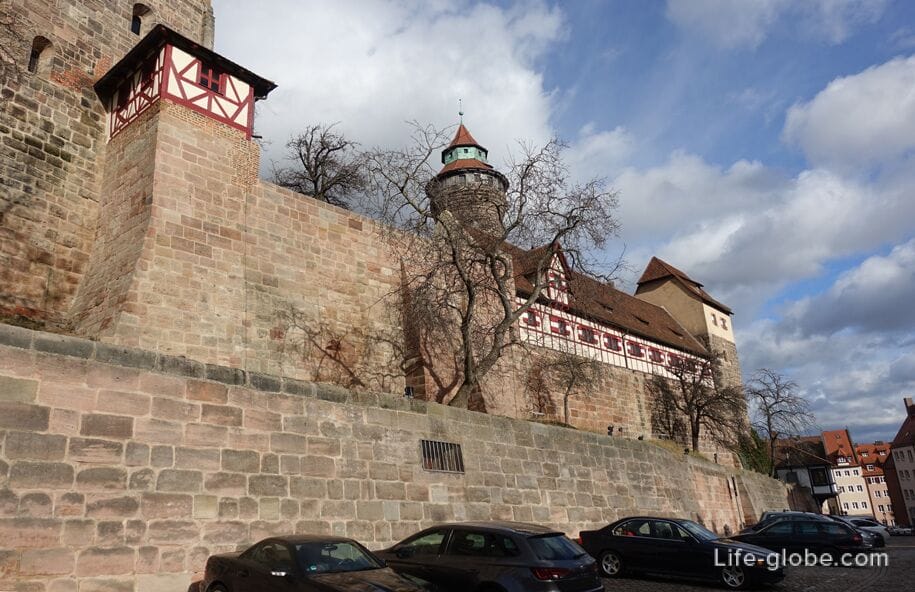
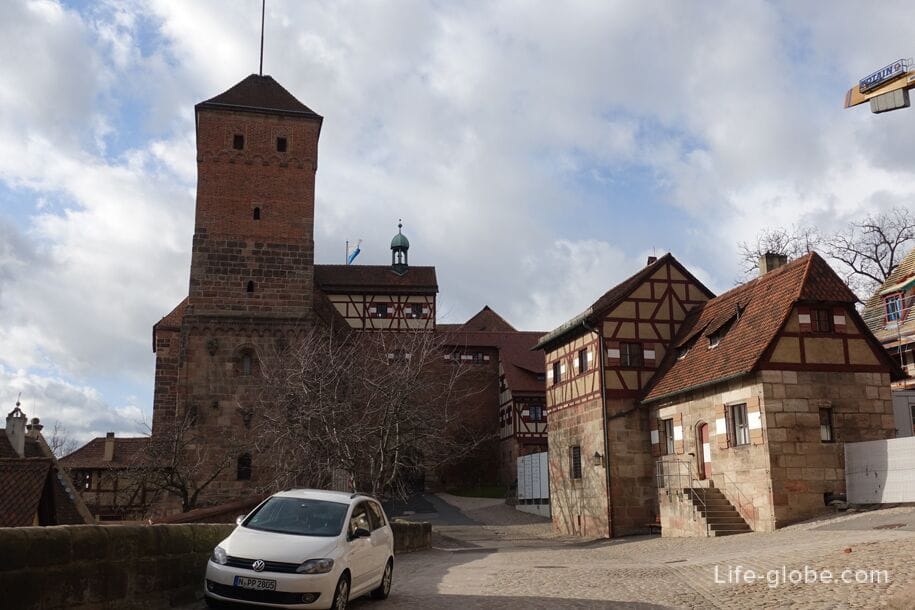
The Albrecht Dürer House-Museum (Albrecht-Dürer-Haus / Albrecht-Dürer-House) is a preserved half-timbered house built around 1420.
From 1509 until his death in 1528, Albrecht Durer (1471-1528), a German painter, engraver and graphic artist of the Renaissance period, lived and worked in the house.
Since 1871, the building has been a house museum dedicated to the life and work of Durer.
On the square near the Durer House Museum are notable: the sculpture "Durer's Hare" (Dürer-Hase Skulptur) and Pilate's house (Pilatushaus), on the corner of which there is a statue of St. George, dressed in knight's armor and standing on a defeated dragon.
Address of the Durer House-Museum: Albrecht-Dürer-Straße, 39. More about the Durer House Museum...

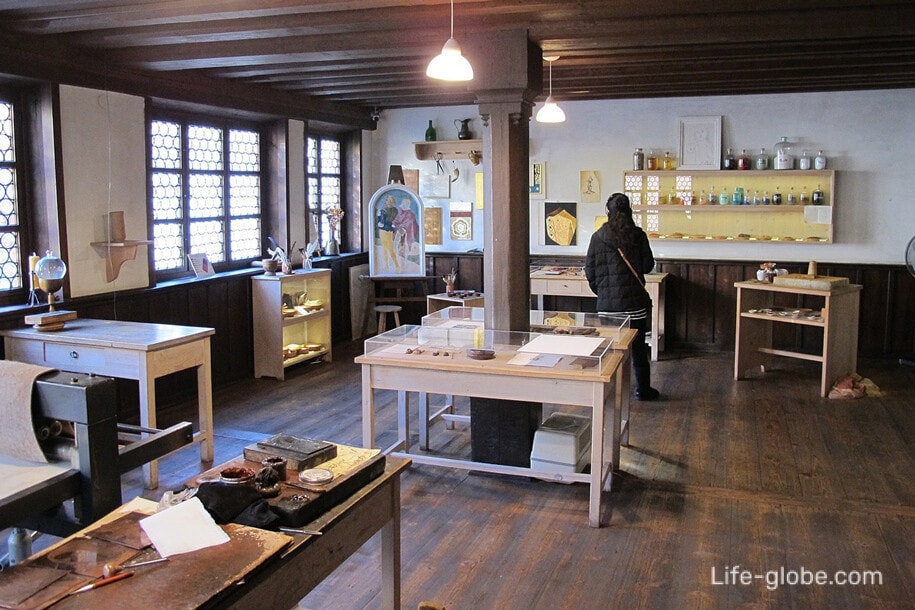
Weißgerbergasse is one of the most beautiful streets in Nuremberg, along which there are historical buildings, including half-timbered houses.
The name of the street comes from white tanners (Weißgerbern) who lived and worked in houses on the street in the Middle Ages.
More than twenty medieval artisan houses survived during the Second World War. Subsequently, they were carefully restored. More about Weissgerbergasse street...
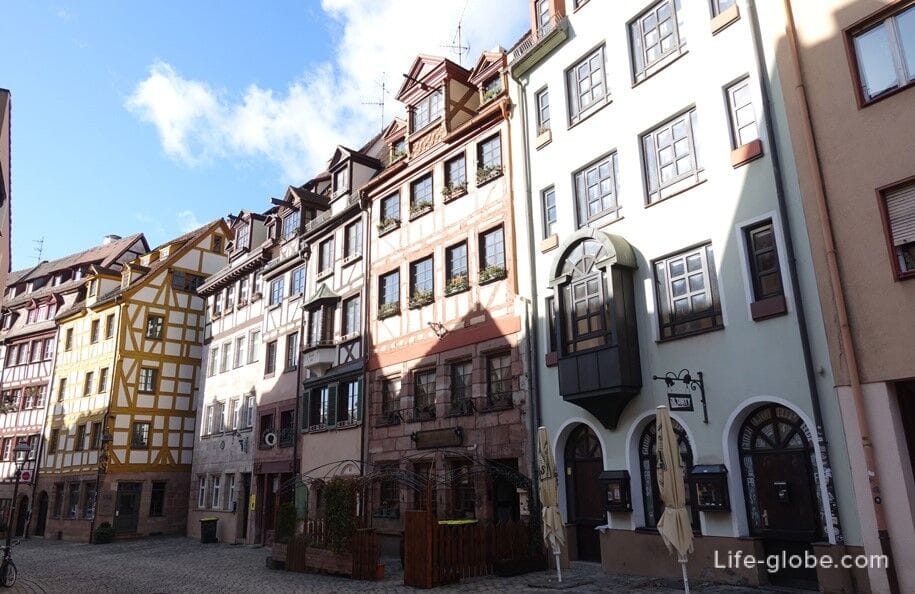

Hallersches Haus, built in 1517 as an estate for the noble Nuremberg Haller family.
The exterior of the house is notable for the bay window, which was erected around 1720. The stepped pediment with scrolls and turrets is made in the German Renaissance traditions.
Today , the historic building housesThe Nuremberg Toy Museum (Spielzeugmuseum), which is one of the most famous museums of its kind in the world.
The museum's collection displays the cultural history of toys from ancient times to the present day and contains about 87,000 exhibits, of which only a part can be seen on the museum's exhibition areas.
House address: Karlstraße, 13-15. More about the toy house and museum...

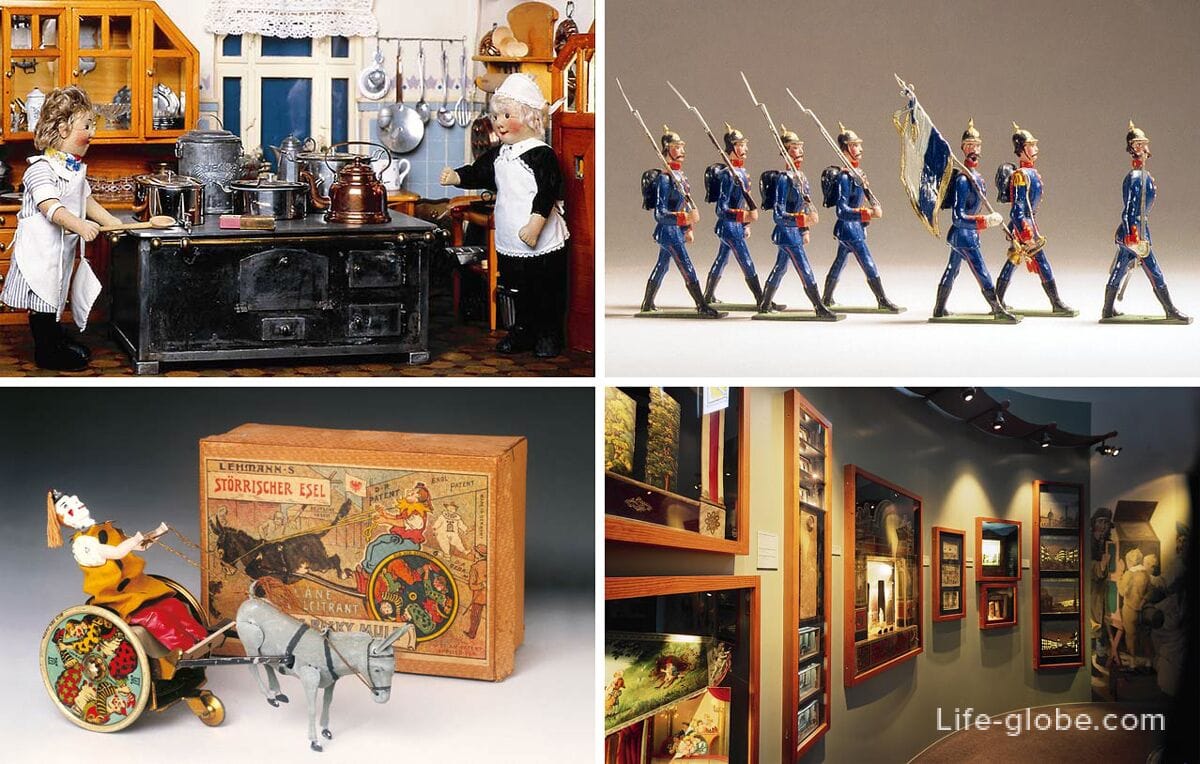
Fembo House (Fembo-Haus) is the only large merchant house of the late Renaissance preserved in Nuremberg, in the walls of which it is now locatedNuremberg City Museum (Stadtmuseum).
The house was built in the period from 1591 to 1596 on the site of a previously existing building.
During its history, the house has changed several owners who have made their own changes to the interior of the building. The exterior of the house did not change.
House address: Burgstraße, 15. More about the Fembo House and the Nuremberg City Museum...
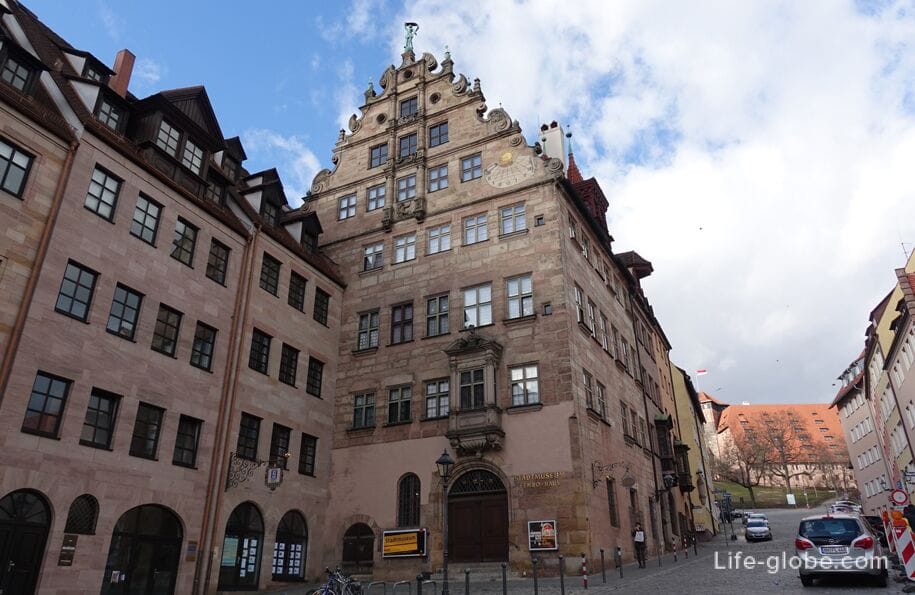
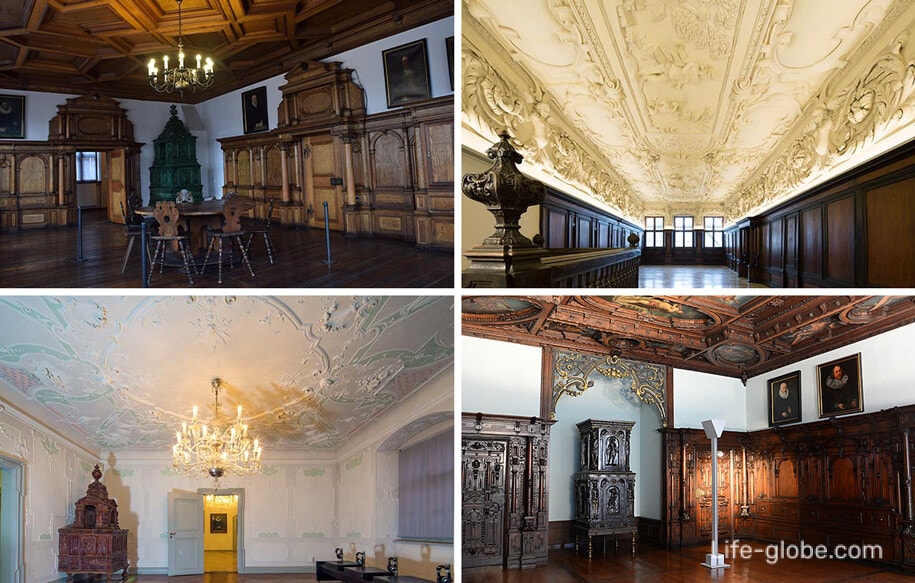
Hangman's bridge (Henkersteg), round tower on the wall of the Executioner (Henkerturm) and half-timbered building of the former wine warehouse (Weinstadel), which are one of the most recognizable and visited architectural ensembles of Nuremberg, which, in addition to these buildings, also includes: square water tower (Wasserturm), dwukrotny the connecting bridge (Pesnicky bridge / Pegnitzüberbrückung).
This "magnificent six" is a single, one of the most famous, photographed and, without a doubt, impressive architectural ensemble of Nuremberg.
The ensemble is located on the western bow of the island "Flea Market" (Trödelmarkt) on the Pegnitz River. More about the ensemble...

The Hospital of the Holy Spirit (Heilig-Geist-Spital / Heilig-Geist-Spital) is the oldest and once the largest medical institution in Germany.
The hospital was built in 1332-1339 together with the church. The infirmary, as in many medieval cities, was dedicated to the Holy Spirit.
The walls of the hospital now house a nursing home and a restaurant "Heilig-Geist-Spital Nürnberg", with tables in the courtyard.
Due to the fact that the wing of the hospital is located above the waters of the river, and its arches are lowered into the water, locals also call the hospital "Nuremberg Glasses". Also noteworthy is the restored picturesque bay window with a pointed tower.
The hospital is located on the bow of the island of Schuette, at the address: Spitalgasse, 16. More about the Hospital of the Holy Spirit...
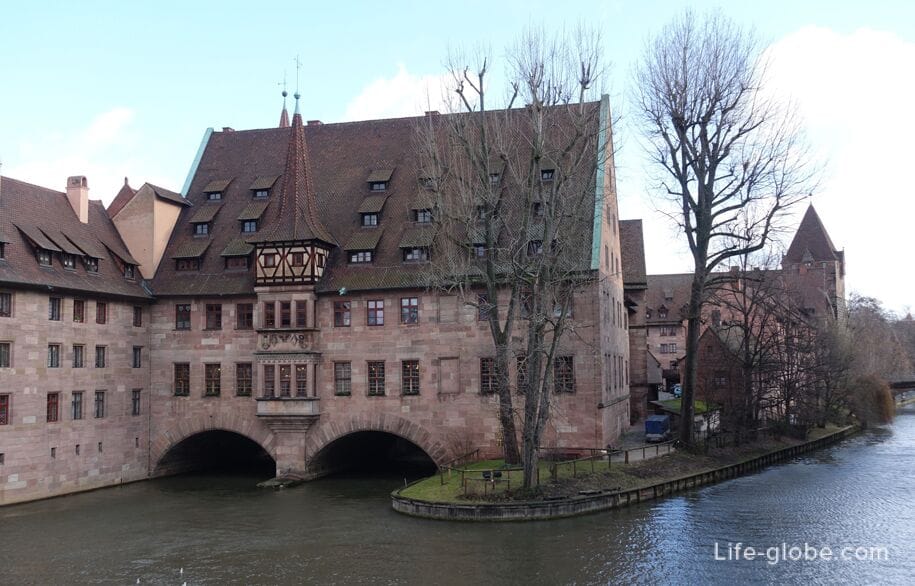
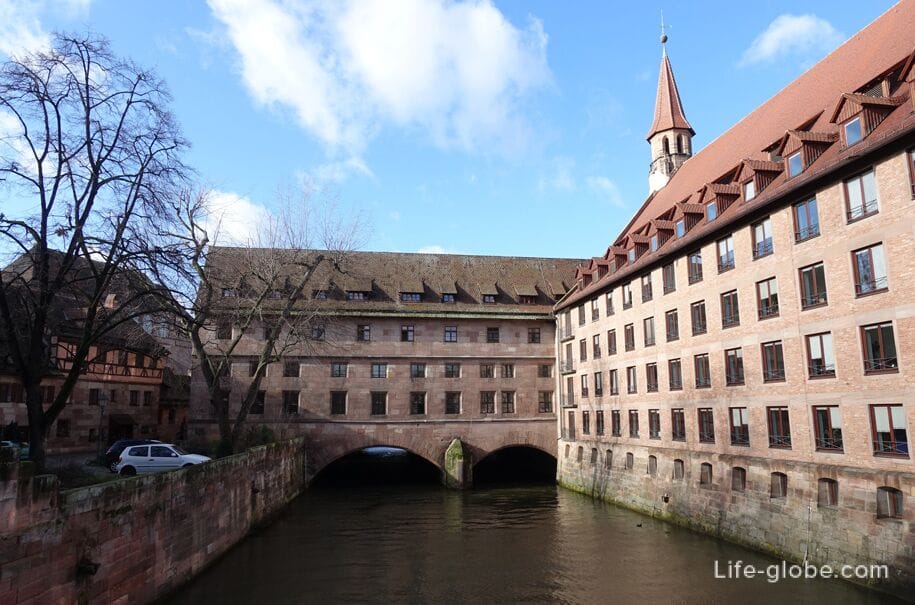
The German National Museum (Germanisches Nationalmuseum) is the largest museum of the cultural history of German-speaking regions in Germany.
The museum's collections showcase the history, culture and art of the regions where German is spoken or was once spoken, from prehistoric times to the present day.
The buildings of the museum represent an ensemble, part of which forms the former Carthusian monastery, and part - more modern buildings.
Museum address: Kartäusergasse, 1. More about the German National Museum...
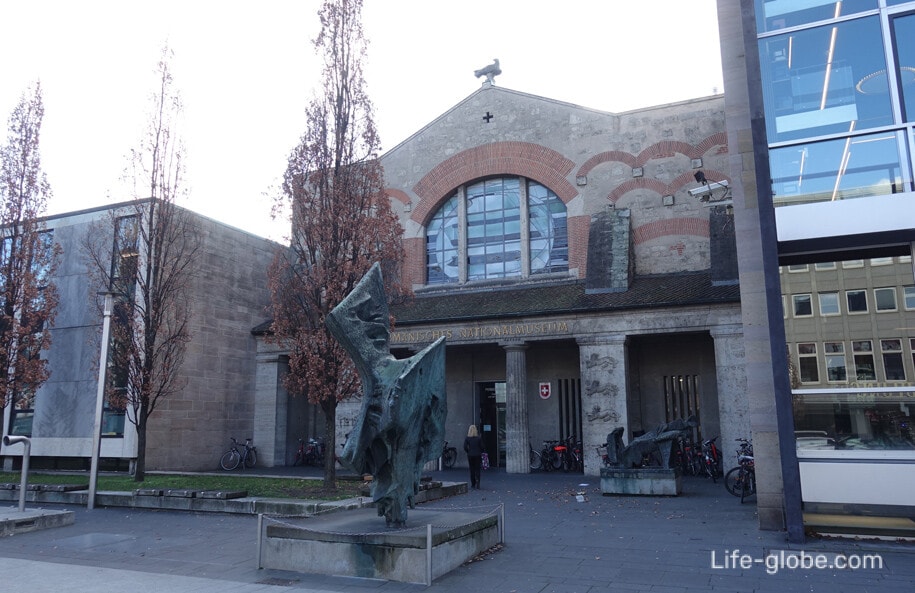

The fountain "Marriage Carousel" (Ehekarussell / Ehebrunnen) is a large-scale architectural fountain built in 1984.
The large sculptural composition of the fountain, made of bronze and marble, which is placed in the marble bowl of the fountain, represents six sculptural groups dedicated to and illustrating the images of the work of the German Meistersinger and playwright Hans Sachs (16th century) - "Bittersweet Family Life", written for his wife.
The sculptural pedestal depicts Hans Sachs himself, in a dancing pose.
Near the fountain are notable: The White Tower (Weißer Turm), the Church of St. Elizabeth (St. Elisabeth Church) and the Church of St. Jacob (Kirche St. Jakob).
The fountain is located on Ludwigsplatz Square. More about the fountain "Marriage carousel"...
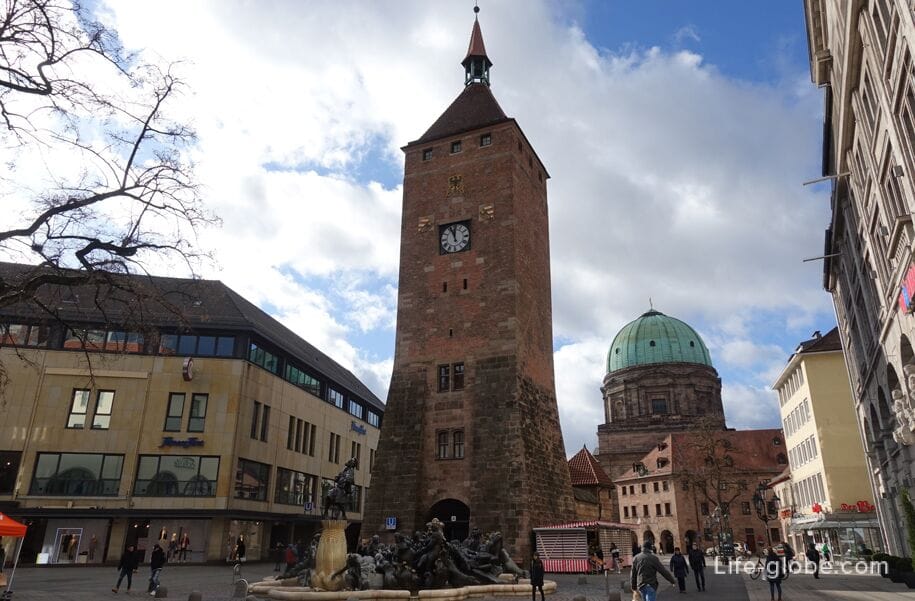
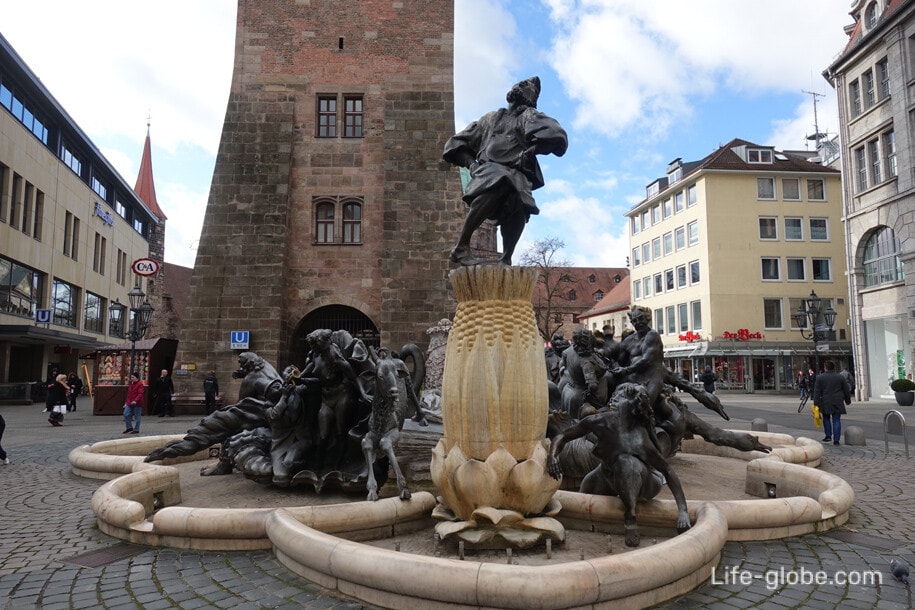
The Nassau House, also known as the Schlusselfelder Foundation House (Schlusselfeldersche Stiftungshaus) is a medieval residential tower, which is the only surviving residential tower in Nuremberg, and is considered one of the few examples of Romanesque architecture in the city.
The Nassau House has a corner location and is built in a row with other buildings. It is made of red sandstone on the model of northern Italian residential towers. It has four floors and a gallery, which is crowned by a high roof.
Near the Nassau house stands the outstanding Gothic Church of St. Lawrence (Kirche St. Lorenz).
Address of the house of Nassau: Karolinenstraße, 2. More about the House of Nassau...
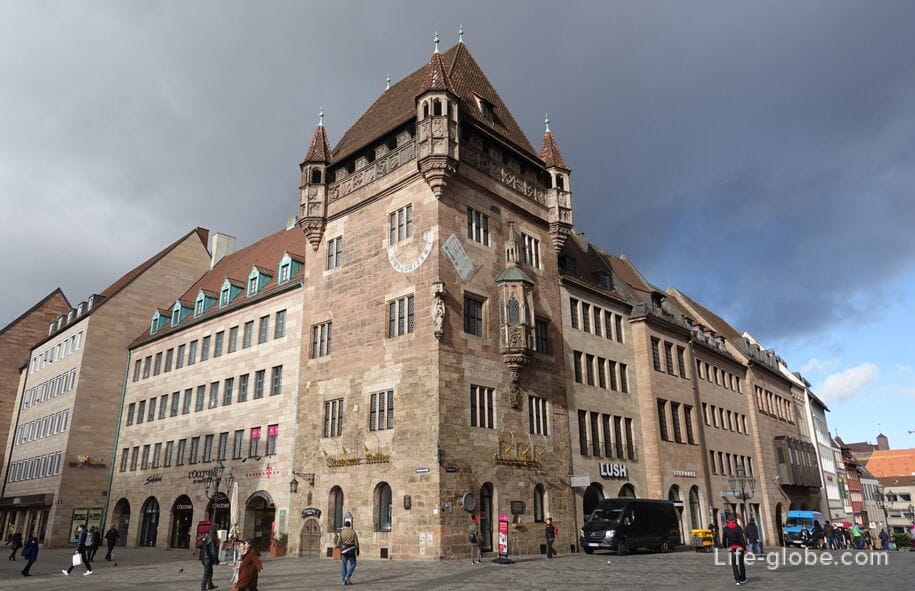
The Peller House (Pellerhaus), also referred to as "Mayersches Pellerhaus" in relation to the post-war building, is a building that has an attractively restored historic ground floor and part of the courtyard integrated into the new building.
The building in the style of Italian palaces was built for Martin Peller according to the plans of architect Jacob Wolf the Elder from 1602 to 1605 on the site of the former estate.
During the Second World War, the Pellerhaus was almost completely destroyed. Subsequently, only the arched walls up to and including the first floor and partially the courtyard of the former outstanding mansion were preserved and reconstructed. In 1957 they were integrated into a new building.
The address of the Peller house: Egidienplatz, 23. More about the Peller House...
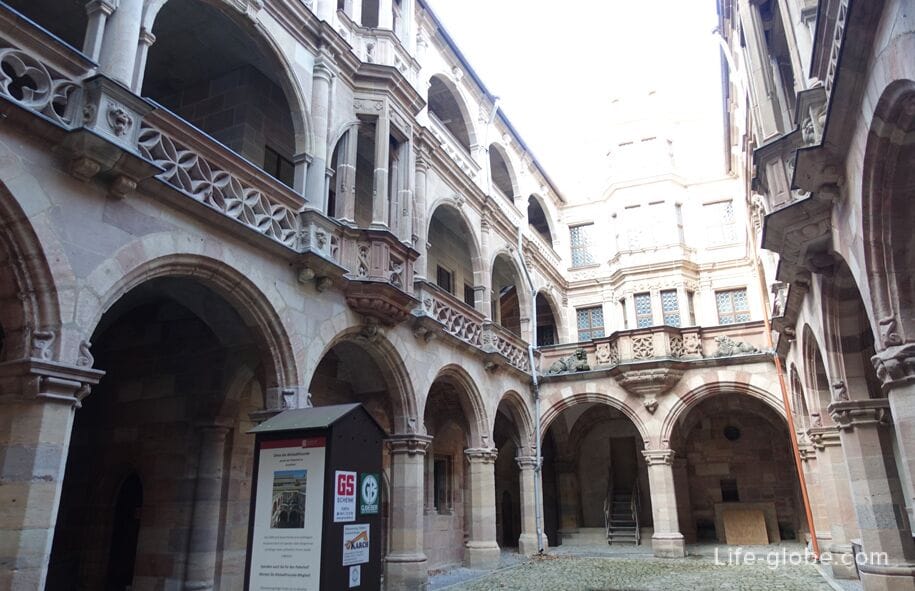
The Castle of Tuchers (Tucherschloss) is the historical residence of the noble patrician family of Tuchers (Tuc).
The residence was built by Lorenz Tucher in 1533-1544, according to the designs, probably, of Paulus Boeheim, who designed the building based on the castles of the French Renaissance.
Today, a museum is located within the walls of the former residence. The castle garden is adjacent to the museum.
Castle address: Hirschelgasse, 9-11. More about the Tuher Castle and the museum...
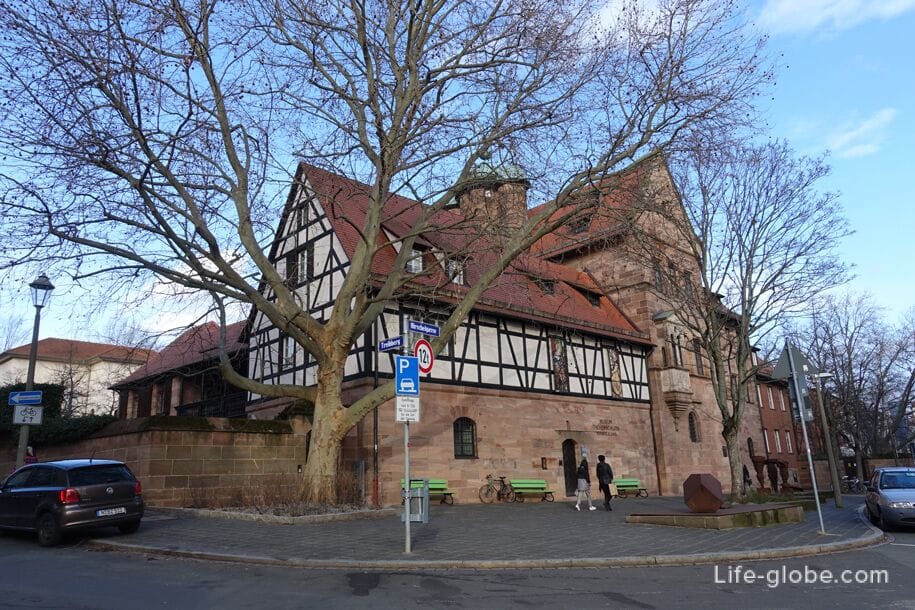
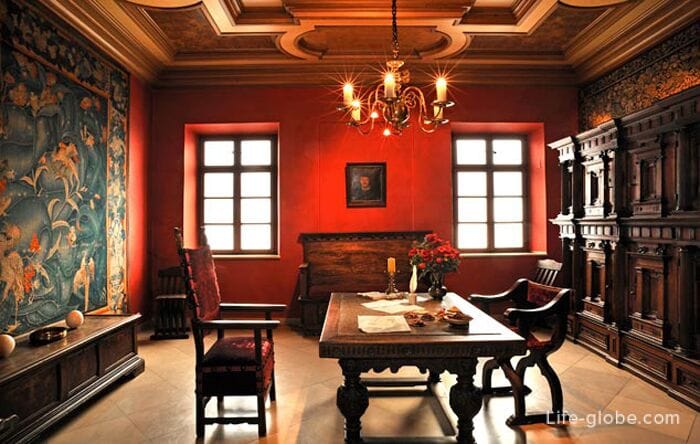
The Artisans' Yard or Craft Yard (Handwerkerhof Nürnberg) is a remarkable corner in Nuremberg, located on the southeastern outskirts of the old town, opposite the Central Railway Station (Nürnberg Central Station).
The characteristic structures of the Craft Yard are small buildings with imitation half-timbered facades.
Craft and souvenir shops, shops, cafes and restaurants are located in the houses, which offer such specialties as: Nuremberg sausages, Franconian beer and specialty wines, Nuremberg gingerbread, as well as wooden and tin toys, local souvenirs and other goods, including handmade. Learn more about the Craft Yard...
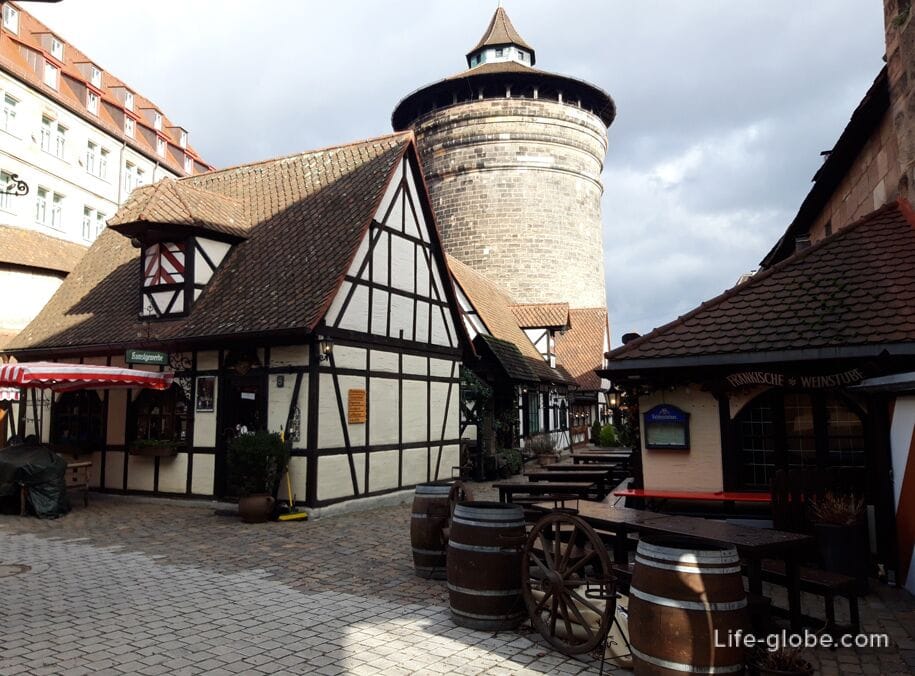
The German Museum of Nuremberg (Deutsches Museum Nürnberg), which is the Nuremberg branch The German Museum of Masterpieces of Science and Technology in Munich (Deutsches Museum).
The museum has several thematic exhibitions dedicated to the following topics: work and everyday life, body and soul, system city, system earth and space and time.
The museum is informative and interactive.
Museum address: Augustinerhof, 4.
The museum's website: deutsches-museum.de/nuernberg .

It is simply unrealistic to list all the sights and museums (churches, buildings, fountains, towers, monuments, sculptures, etc.) in the old city of Nuremberg in one article. Therefore, if you want to learn more about the old city of Nuremberg, we recommend that you read a separate article that is completely devoted to the old city. Learn more about the old city of Nuremberg...
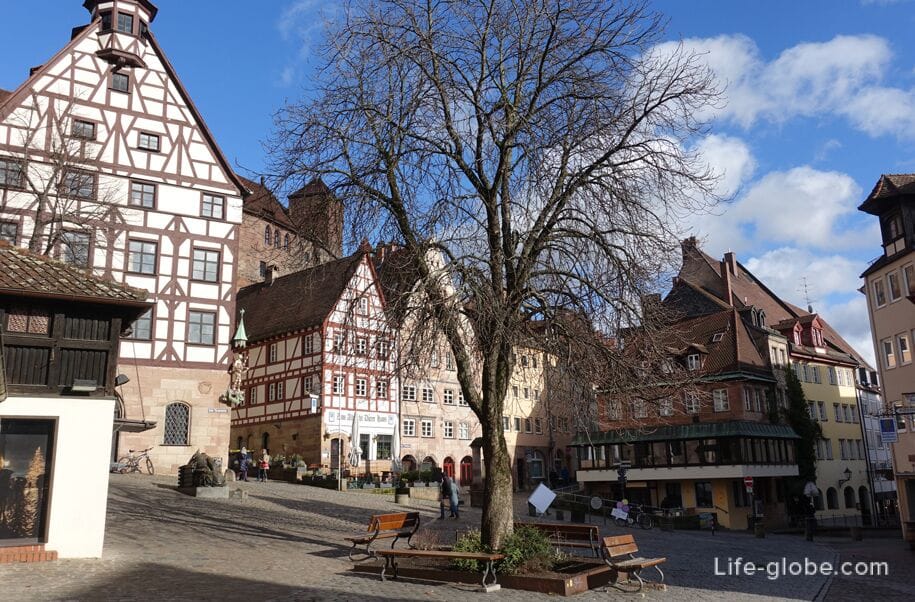
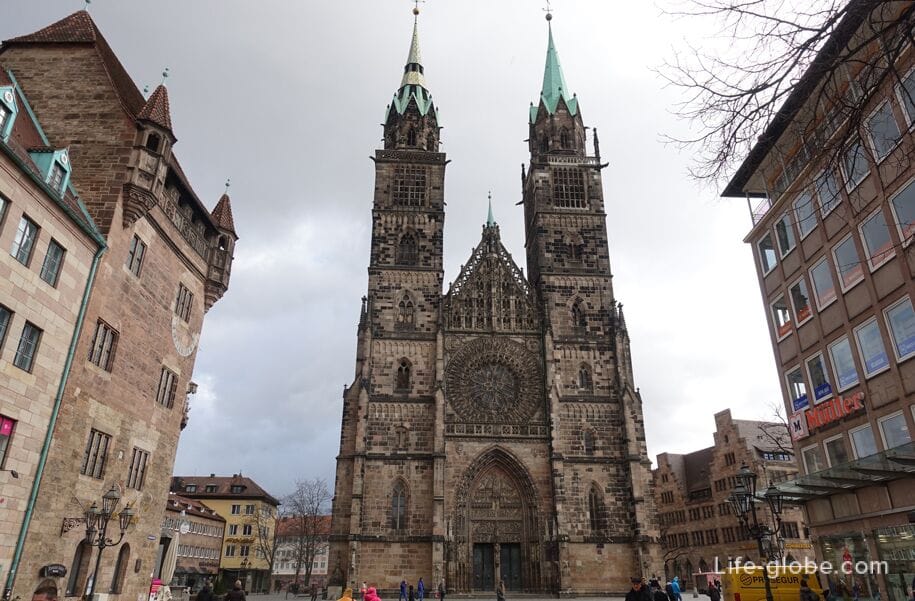
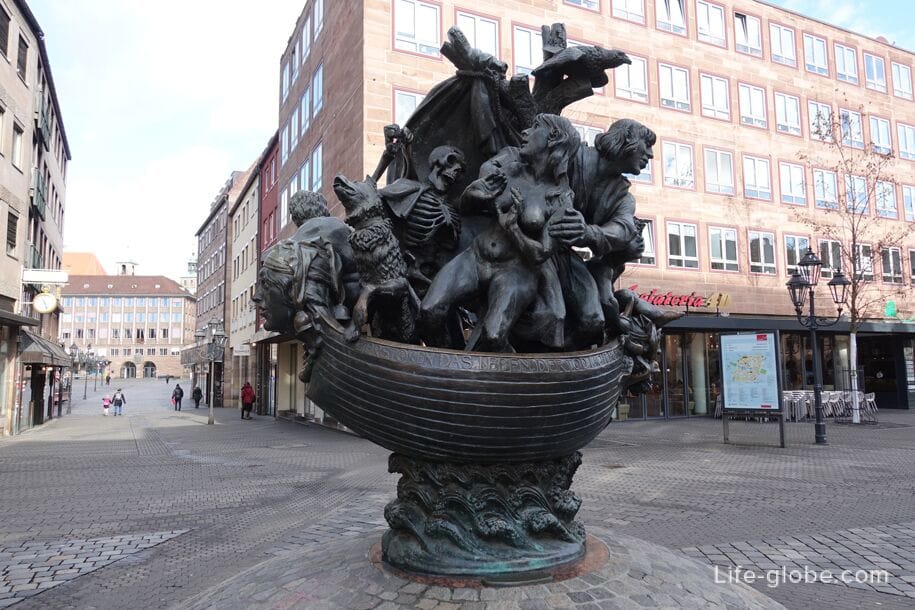
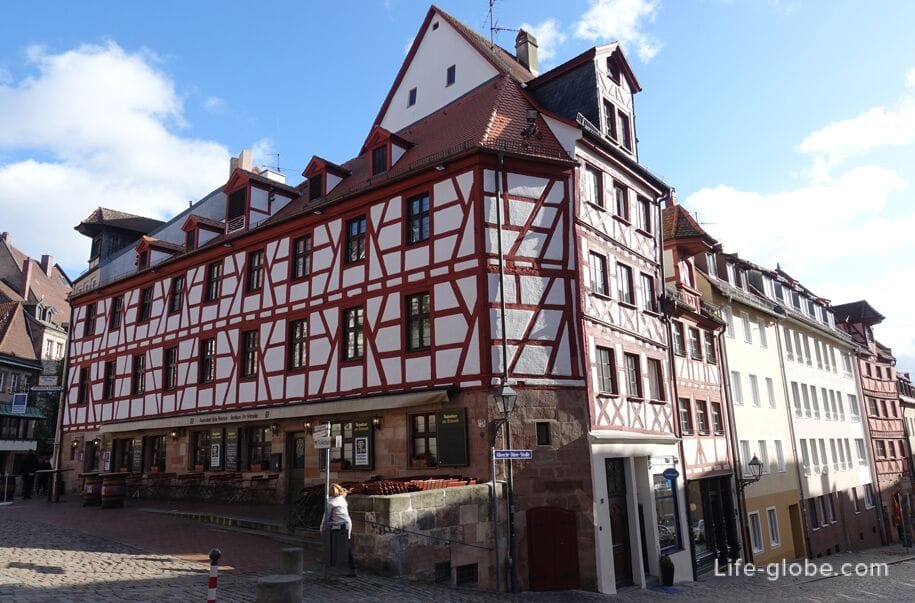
Other sights and museums of Nuremberg
There are also important sights and museums outside the city walls of Nuremberg's old town.
Hesperides Gardens
The Hesperid Gardens (Hesperidengärten) were originally part of the green belt of gardens along the city walls. Such gardens were popular with aristocrats in the 16th and 18th centuries. Citrus fruits, vegetables and herbs were grown in the gardens.
Small ornamental gardens were built around the summer residences of the rich in both Renaissance and Baroque styles, and equipped with a large number of fountains and sandstone figures. Valuable and exotic collections of lime and bitter oranges were grown in luxuriously decorated gardens, lawns and flower beds were also arranged in the gardens.
The Hesperides Gardens are located to the west of the old town (outside the city walls) and has only a few preserved plots and relics of the former magnificent setting. The narrow and rectangular gardens are orthogonal and oriented from north to south. And the former dachas of patricians and merchants form the structural border of small territories.
Thus, the three combined gardens at the back of the houses on Johannisstrasse 43-47 and the garden behind the house on Johannisstrasse 13 are open to the public.
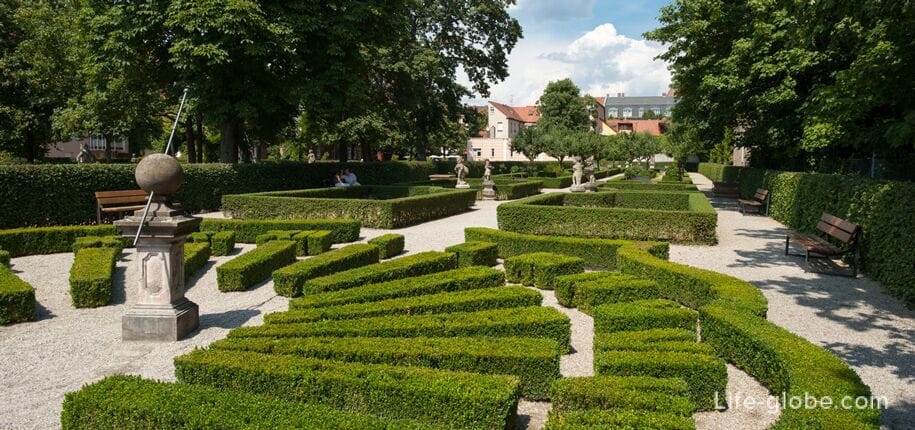
Cemetery of St. John and St. Rochus
The cemetery of St. John and St. Rochus (Johannisfriedhof) is a medieval cemetery outside the city walls, which is officially considered the most beautiful cemetery in Germany.
The cemetery is known for elaborate epitaphs and some tombstones. Among other celebrities, Albrecht Durer is buried in the cemetery.
In the cemetery is the chapel of St. Rochus (Church of St. John). The choir was opened in 1377, and the nave in 1395, and the sacristy was added in 1446. Subsequently, the chapel was reconstructed.
Website: st-johannisfriedhof-nuernberg.
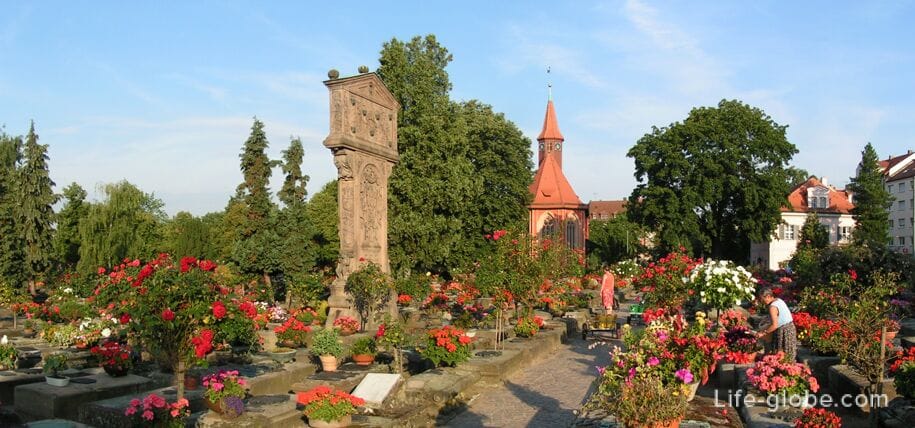
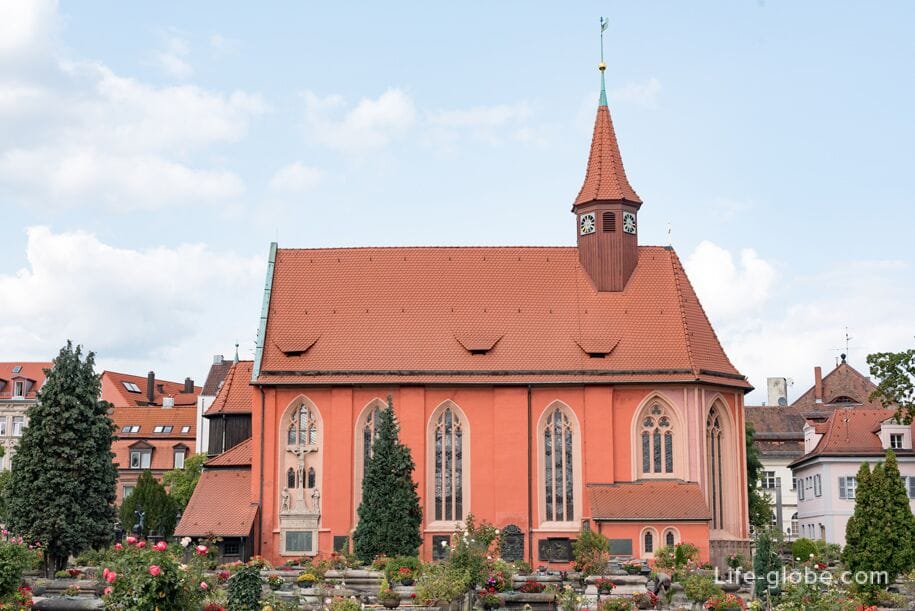
Memorial of the Nuremberg Trials
The Nuremberg Trial Memorial (Memorial Nürnberger Prozesse) is a museum of the history of the Nuremberg Trials, located in the Palace of Justice in Nuremberg, in the room where the trials of leading representatives of the National Socialist regime took place.
The museum includes:
- Hall 600, where in 1945-1949 the Nuremberg trials of prominent representatives of the political, military, judicial and economic leadership of Nazi Germany who planned, committed or otherwise participated in the Holocaust and other war crimes took place;
- a permanent exhibition that provides information about the history, participants, the course and consequences of the trial, the prosecution of Nazi crimes after 1946.
Museum address: Bärenschanzstraße, 72. More about the Museum of the History of the Nuremberg Trials...
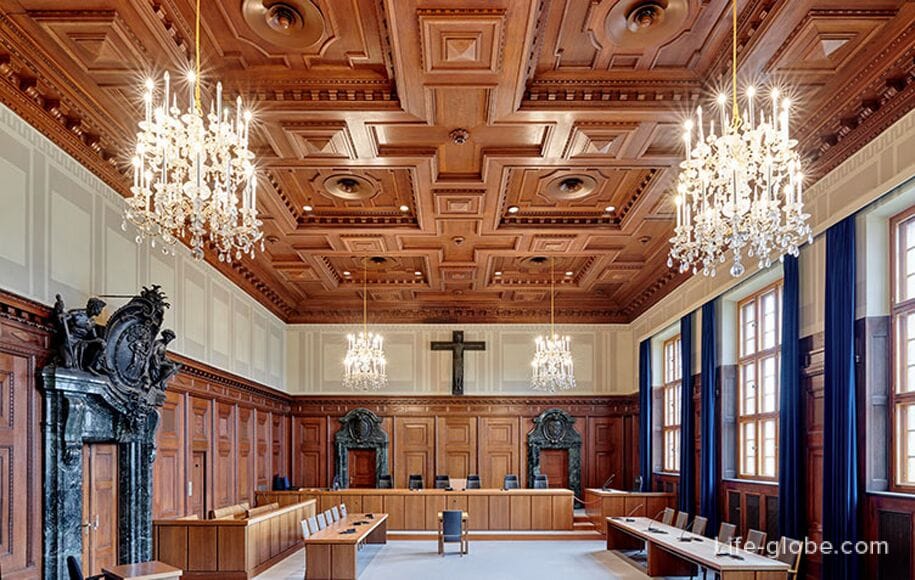
Nuremberg State Theatre
The State Theater of Nuremberg (Staatstheater Nuremberg) is one of the largest diversified theaters in Germany, the building of which is a complex consisting of old and new parts.
The theater was built from 1901 to 1905 in the Art Nouveau style and then it was the Nuremberg Opera House (Opernhaus Nürnberg).
In 1959, the theater building was expanded thanks to the addition of the dramatic chamber theater, which became part of the architectural complex of the state theater.
Today, the "old" neoclassical with groups of sculptures and mosaics, and the "new" theater buildings represent a single theater complex.
Theater address: Richard-Wagner-Platz, 2-10. More about the Nuremberg State Theater...
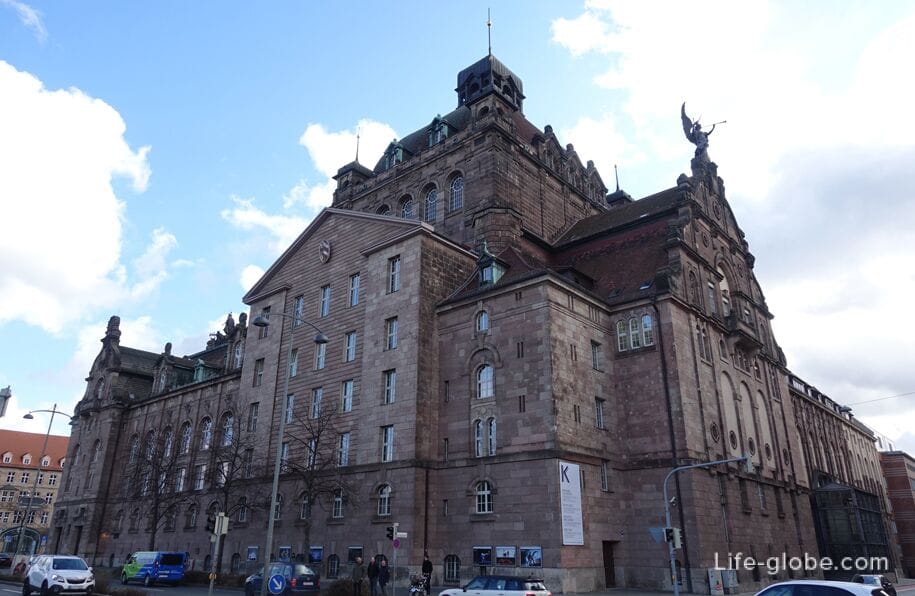
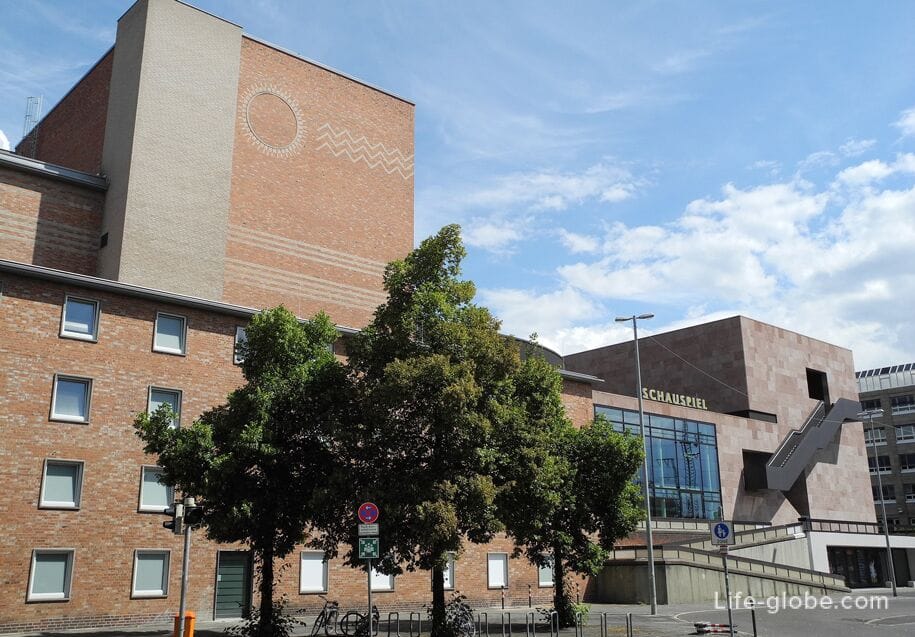
Nuremberg Museum of Transport
The Nuremberg Transport Museum (Verkehrsmuseum Nürnberg) was founded at the end of the 19th century and is one of the oldest museums of technical history in Germany. It has interactive exhibits, models and original trains.
The Nuremberg Transport Museum consists of the Museum of German Railways (Deutsche Bahn) and the Museum of Communications (Museum für Kommunikation), located in a historic building in the center of Nuremberg.
Museum address: Lessingstraße 6. More about the Nuremberg Museum of Transport...
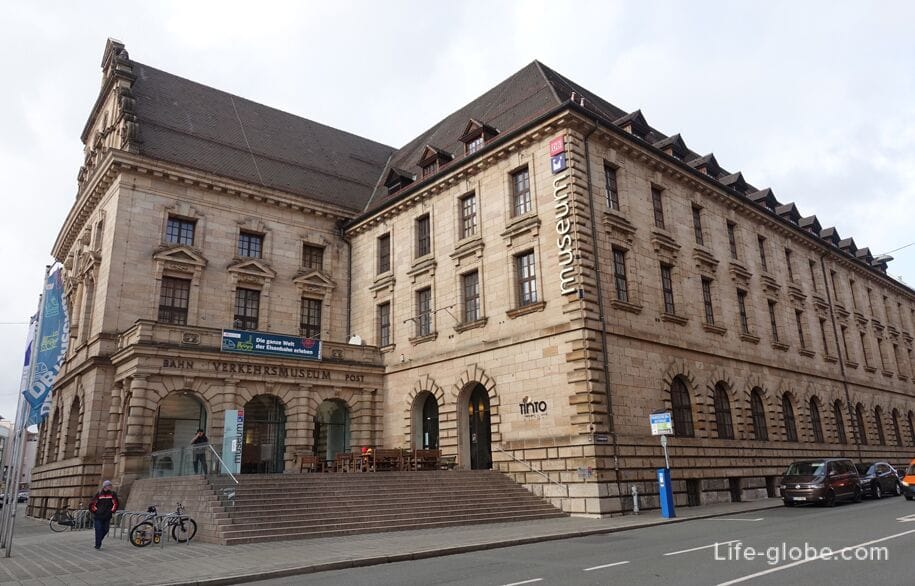
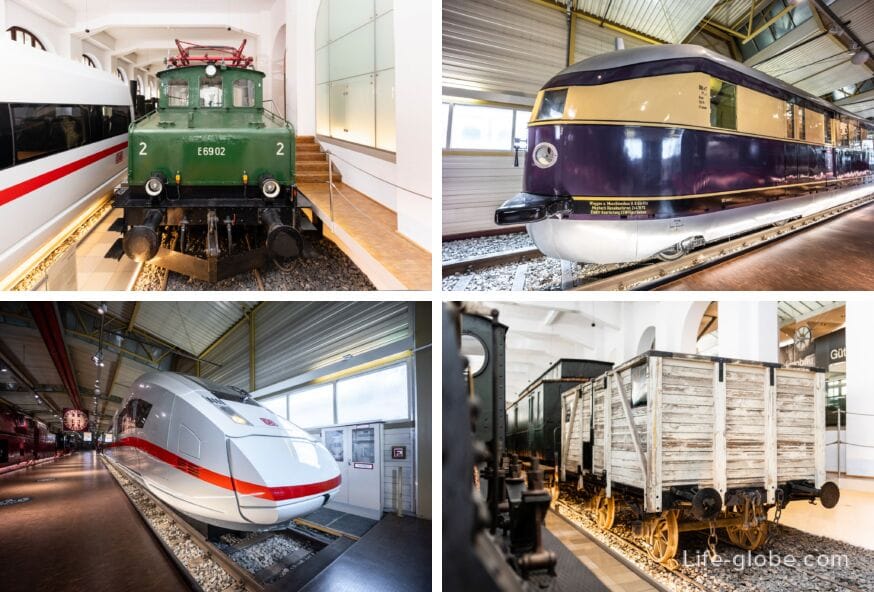
Documentation center of the territory of the party congresses
The Documentation center of the territory of the party congresses or the Documentation center of the NSDAP Party congresses (Dokumentationszentrum Reichsparteitagsgelände) is a museum located in the northern wing of the unfinished new Congress Palace on the former territory of the party congresses, designed in the project for 50 thousand spectators. In the Third Reich, Nuremberg was the "city of the NSDAP party congresses", where from 1933 to 1938 the National Socialists held meetings of the Nazi Party.
The permanent exhibition tells about the origins, content and consequences of the National Socialist totalitarian regime. The central theme of the sections of the exposition organized in chronological order is the history of the NSDAP party congresses, at which ostentatious "unity of the nation" was demonstrated in the form of mass events for the purposes of National Socialist propaganda.
The exhibition also includes stands containing information about the history of each object on the territory of the NSDAP party congresses.
The Documentation Center regularly hosts special thematic exhibitions and training programs for people of different ages.
The address of the center: Bayernstraße, 110.
Museum website: dokuzentrum.
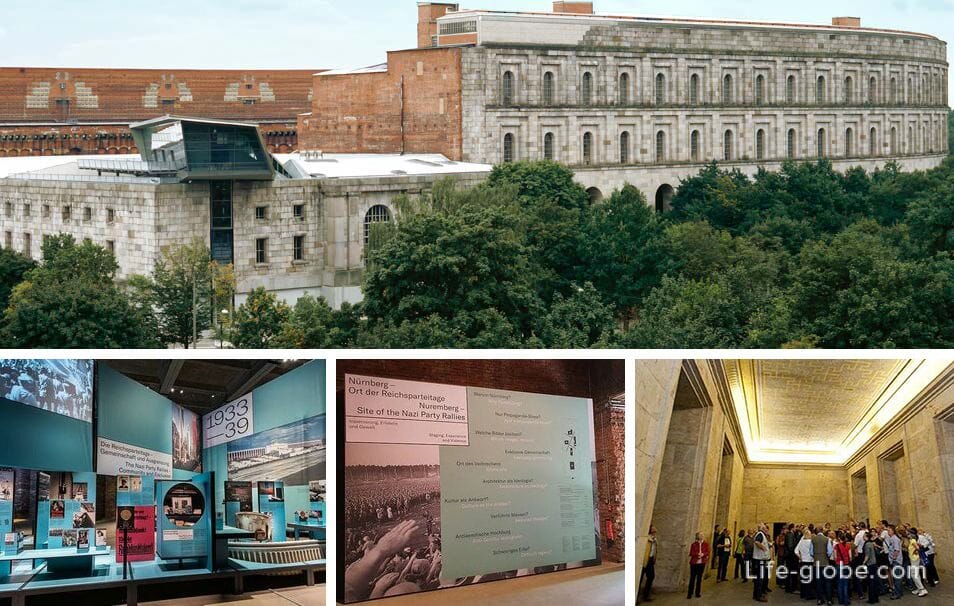
Museum of Industrial Culture
The Museum of Industrial Culture (Museum Industriekultur) is an interactive museum of technology, culture and social history, which shows the history of industrialization on the example of Nuremberg from 1800 to the present day.
The museum was established in 1988 in the building of a former metallurgical plant and occupies about 6000 m2 of exhibition space.
In the museum: historically decorated premises, including residential, a printing house, a grocery store, a dental office, a theater, etc.; items related to industry and high-speed sports - running, cycling and motorsport.
The address of the museum is: Äußere Sulzbacher Straße, 62.
Museum website: museum-industriekultur.
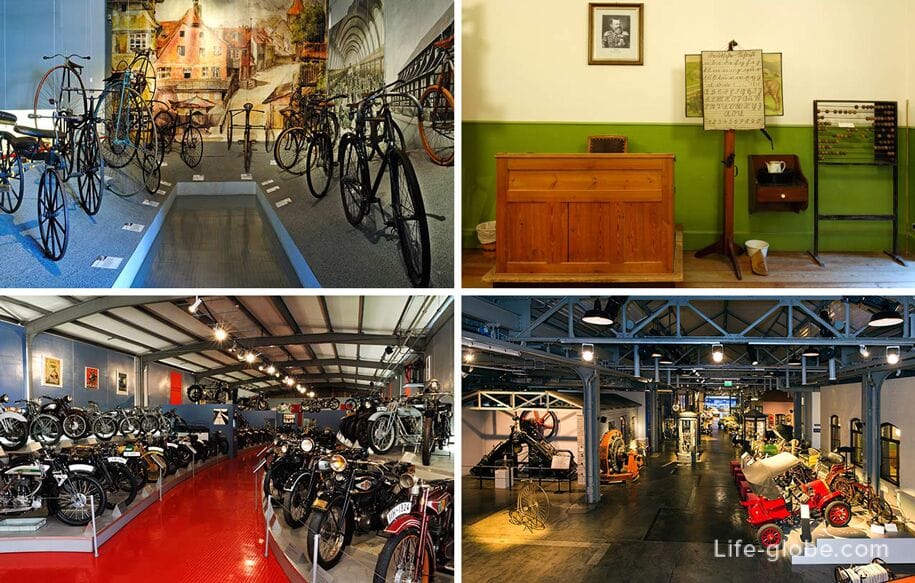
Kunstville - Art Museum
Kunstvilla (Kunstvilla Nürnberg) is a former merchant's mansion built in the neo-Baroque style by architects Heinrich Theodor Schmidt and Georg Richter between 1893 and 1895.
The two-storey building with a mansard roof, stands on a high ground floor and is lined with sandstone, also has several risalits and balconies.
Today, the carefully restored building is an architectural monument and within its walls there is an art museum with exhibitions dedicated to presentation, communication and research of regional art history. The museum shows thematic and monographic exhibitions of 20th and 21st century art from city funds, as well as from public and private collections.
Villa address: Blumenstraße, 17.
The museum's website: kunstkulturquartier.de/kunstvilla .

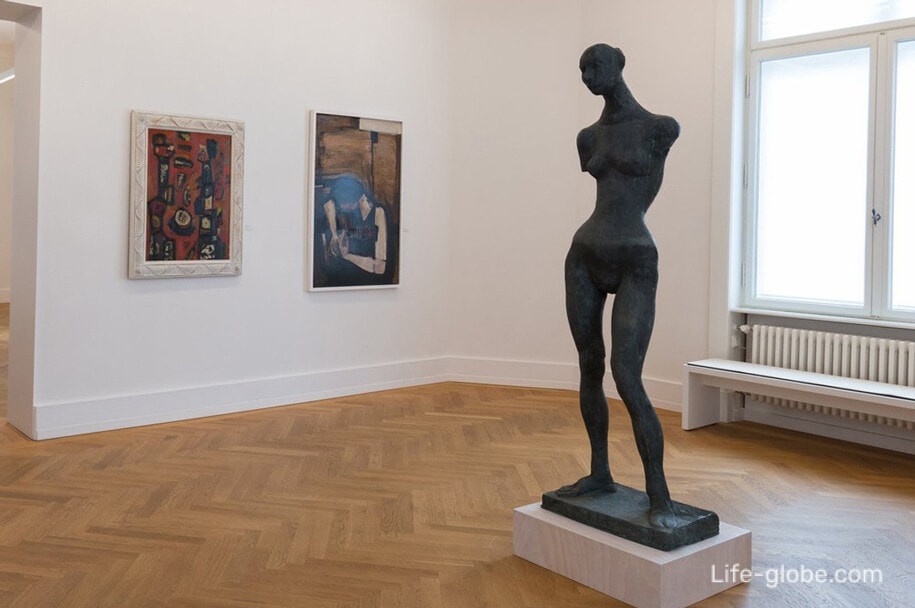
Nuremberg Telecommunications Tower
The Nuremberg Telecommunications Tower (Fernmeldeturm Nuremberg), which, because of the egg-shaped tower part, also bears the unofficial name "Nuremberg Egg", is the tallest building in Nuremberg and one of the tallest in Bavaria.
The tower was built between 1977 and 1980 and is now listed as a monument in Bavaria.
The total height of the tower is 293.80 meters. The height of the tower cage is almost 50 meters, and the diameter is 32 meters.
There are three rotating white beacons on the roof of the tower, which are offset by 120 degrees and shine in two directions; they can be turned on and off from the tower at Nuremberg Airport, and they are used for orientation and flight safety.
The address of the tower: Hansastraße, 7A. Learn more about the sights and museums of Nuremberg...
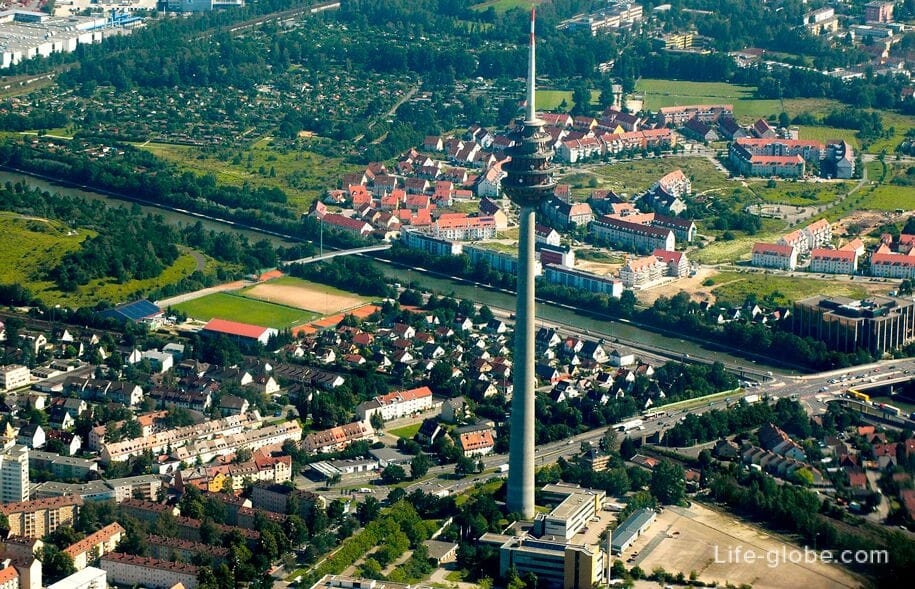
Nuremberg City Park
Of all the parks and green areas of Nuremberg, the Nuremberg City Park (Stadtpark, Stadtpark Nürnberg) stands out especially - a green area in the center of Nuremberg, where there are: alleys for walking, places to relax, flower beds, several monuments, vases, a restaurant, a lake and the famous fountain of Neptune.

The Neptune Fountain (Neptunbrunnen, Neptunbrunnen) is the main decoration of the park and the largest Baroque fountain north of the Alps.
The fountain was created by Nuremberg master sculptors X. Ritter, G. Schweiger and I. Eisler in 1660-1668 as a memorial to peace after the end of the Thirty Years' War.
In 1797, the city sold the fountain of Neptune to the Russian Emperor Paul I, who sent it to the city of St. Petersburg and installed it in The upper garden of the Grand Peterhof Palace in Peterhof.
In the park in Nuremberg there is a copy of the fountain, created from plaster casts in 1896-1902. Learn more about Nuremberg City Park and Neptune Fountain...

Lake Werder
Lake Werder (Wöhrder See) is an artificial lake (reservoir) created in 1891 to protect the old city of Nuremberg from floods.
Today, the lake stretches for 3 kilometers in the center of Nuremberg (near the city wall of the Old City - on its eastern side) and is especially popular as a local recreation area.
There are beach areas, boat and catamaran rentals, an embankment, green spaces and children's playgrounds.
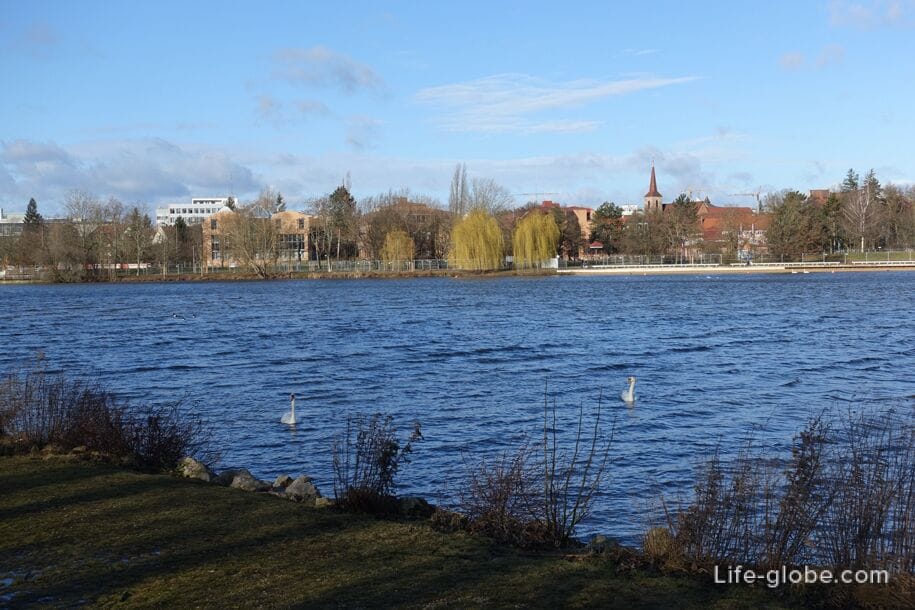
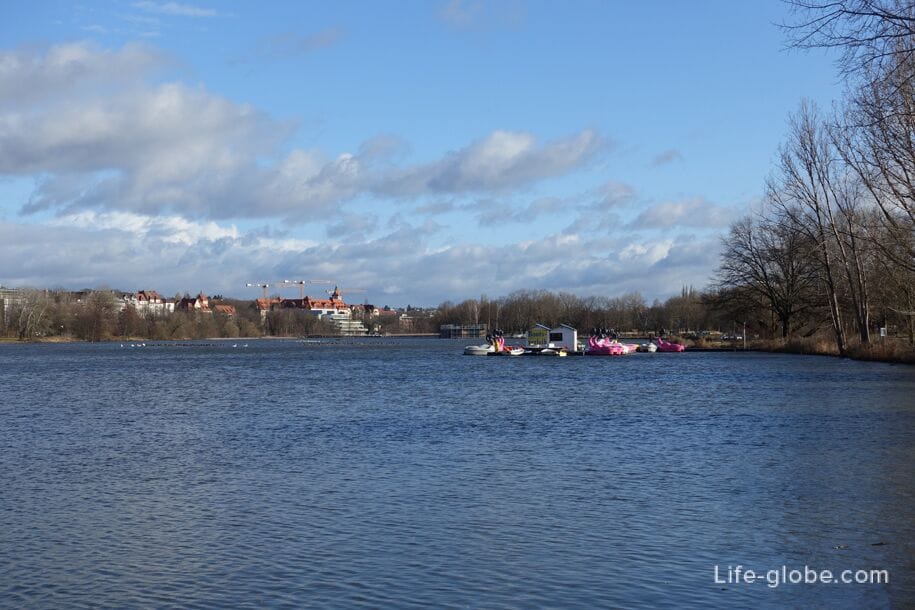
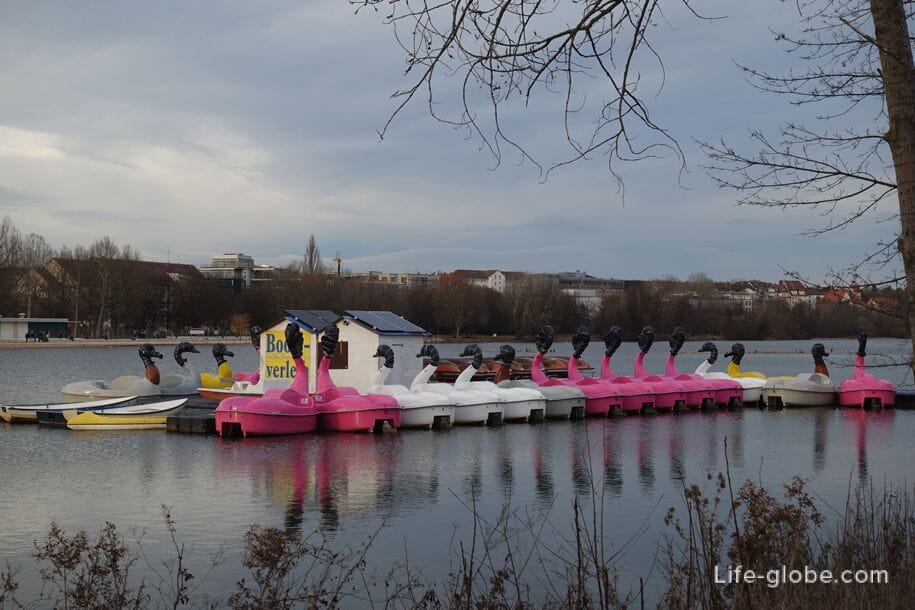
Nuremberg Zoo
The Nuremberg Zoo (Tiergarten Nürnberg) is among the best European zoological parks.
The zoo is home to manatees, sloths, turtles, butterflies, monkeys, beavers, otters, penguins, sea lions and other animals. The zoo's inhabitants represent many continents of the world.
The zoo has a contact area and a children's playground.
Address of the Nuremberg Zoo: Am Tiergarten, 30.
Nuremberg Zoo website: tiergarten.nuernberg.

Nuremberg Planetarium
Nicolaus Copernicus Planetarium is the only major planetarium in Bavaria. Together with the Nuremberg Educational Center (Adult Education Center) and the Nuremberg City Library, the Planetarium forms the Nuremberg Educational Campus.
Because of its synagogue-like architecture, Nuremberg's first planetarium on Rathenauplatz, which was officially opened on April 10, 1927, was demolished during the Third Reich and rebuilt after the war in its new current location.
The dome of the planetarium is 18 meters wide.
The address of the planetarium: Am Plärrer, 41.
Planetarium website: planetarium-nuernberg.
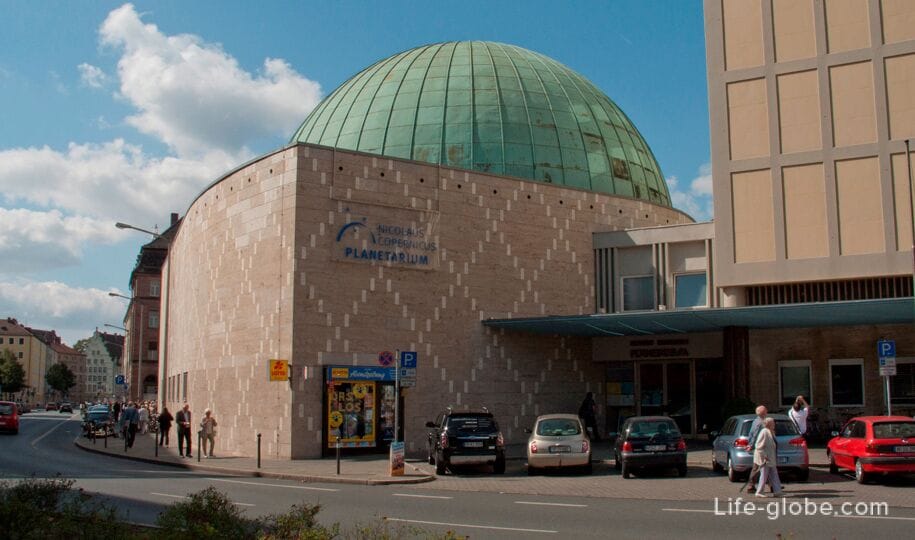
Historic Nuremberg Swimming Pool
The Volksbad Nürnberg indoor swimming pool attracts attention with its historic building, which was built between 1911 and 1913 and is considered the pearl of the Art Nouveau bathing culture in the city.
The architecture of the building is notable for the columns of the portico at the entrance with the coat of arms of the city.
Pool address: Rothenburger Strasse, 10.
Pool website: volksbad.
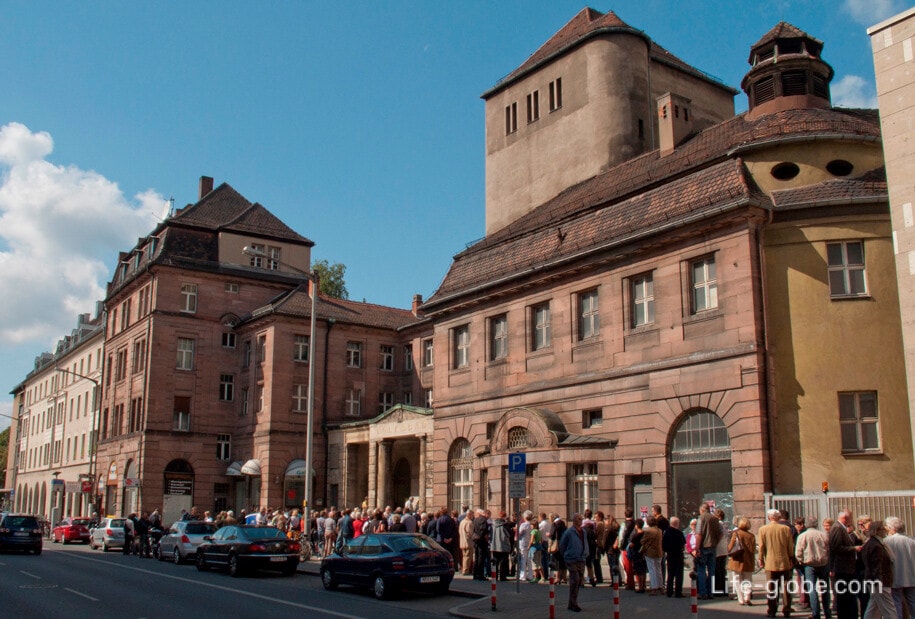
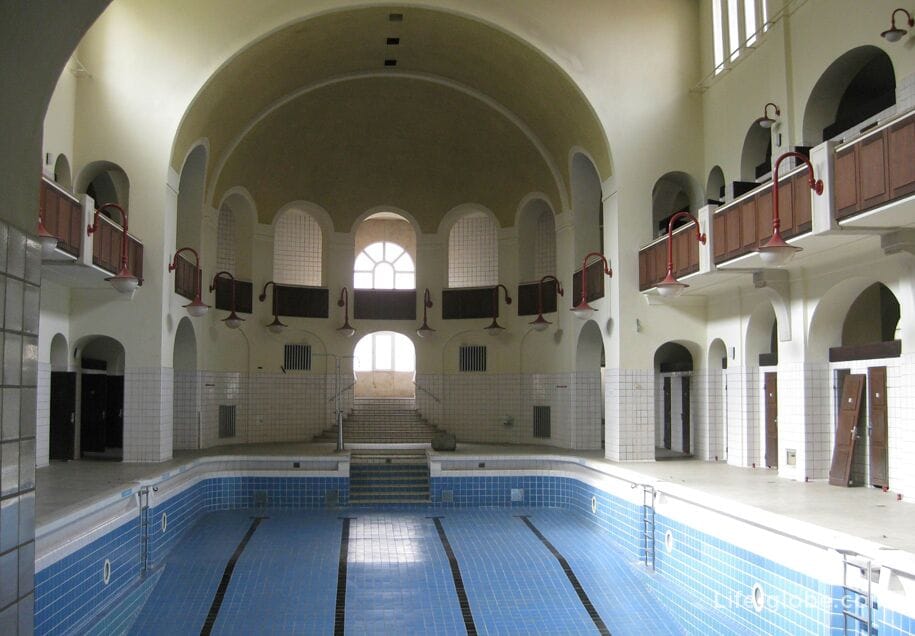
Christmas fairs and other events in Nuremberg
On Christmas Eve, Nuremberg hosts Christmas fairs (Nürnberger Weihnachtsmärkte), which become one of the most visited places in the city.
The Nuremberg Christmas markets are considered one of the most beautiful and colorful in Europe. About 2 million people visit Nuremberg during the Christmas fairs.
Christmas markets are located in the old town of Nuremberg. Learn more about the Christmas markets in Nuremberg...
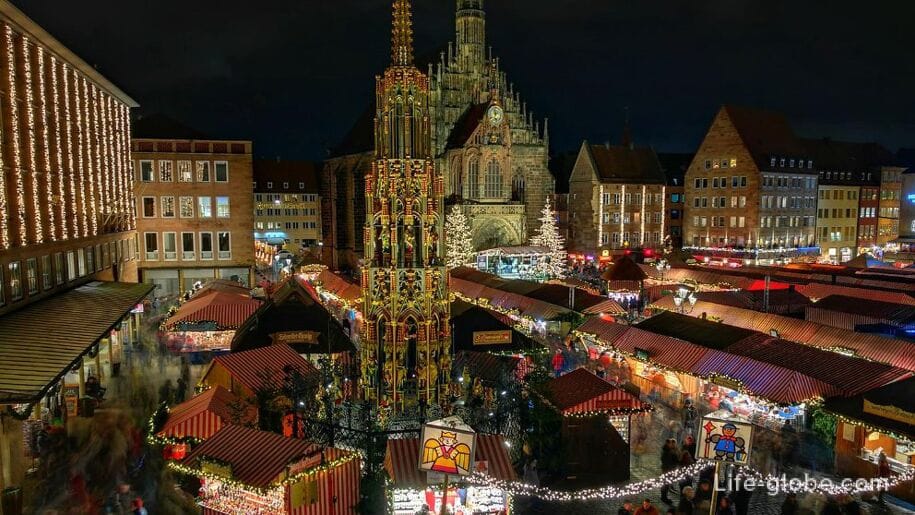
In addition to Christmas fairs, other holidays and festivals are held throughout the year in the city:
- at the end of May, the traditional illumination festival "Blue Night" (Die Blaue Nacht) is held. This is the most important cultural event of the year, the "Night of Art and Culture", which lasts all night. It takes place in various squares in the city center;
- in the spring, a theatrical carnival procession is organized in the city in Rosenmontag (Rosenmontagtsug / Rosenmontagszug);
- every summer in the Luitpoldhain Park, an open-air classical music festival takes place;
- rock music festival "Rock in the Park" (Rock im Park), held in the summer season in the open air. The venue, as a rule, is the Zeppelin fields (Zeppelinfeld);
- the Bardic Song Festival (Bardentreffen), when every year the Old City of Nuremberg turns into a large open-air stage, where for three days the "bards" play for numerous listeners on the streets and squares of the Old City;
- The Old Town festival (Nürnberger Altstadtfest), which takes place every year (sometime in September) It gathers more than one million guests, offering to attend more than 60 events with 800 participants for free, including performances of folklore performers, dramatizations based on the works of Hans Sachs, traditional fishermen's duels and jazz concerts. The venue, as a rule, is the island of Schütt (Insel Schütt) and the Hans-Sachs-Platz square (Hans-Sachs-Platz).

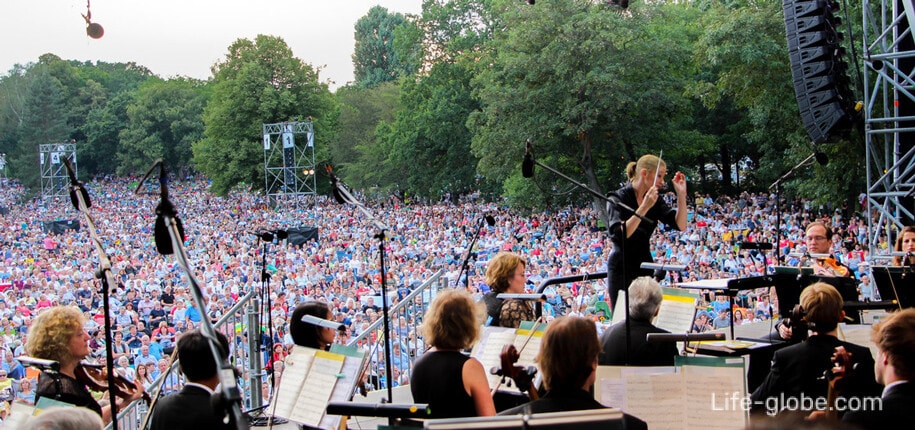
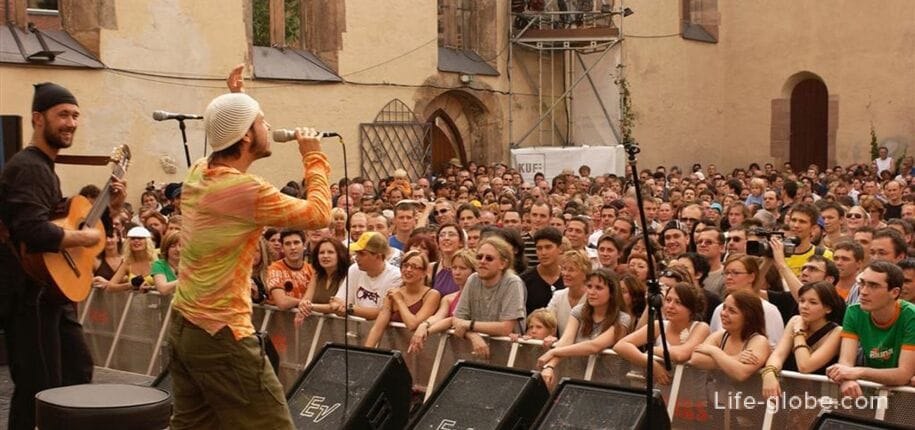
Food and drinks in Nuremberg (beer gardens of Nuremberg)
The local Nuremberg cuisine has absorbed all the delights of Franconia and Bavaria in general.
Meat and flour products are distinguished, as well as potato dishes (including potato dumplings) and cabbage (sauerkraut, red cabbage).
In the city you can try German pretzels, knuckle and potato salad, Saxon roast "Sauerbraten", famous Nuremberg sausages, sausages, baked carp.


The nationally famous Nuremberg gingerbread cookies also embody Nuremberg cuisine. The production of gingerbread in the city has been documented since the 13th century. Traditionally, Knieküchle is baked for the parish fair in summer. Gingerbread cookies become especially popular during the pre-Christmas fairs season.

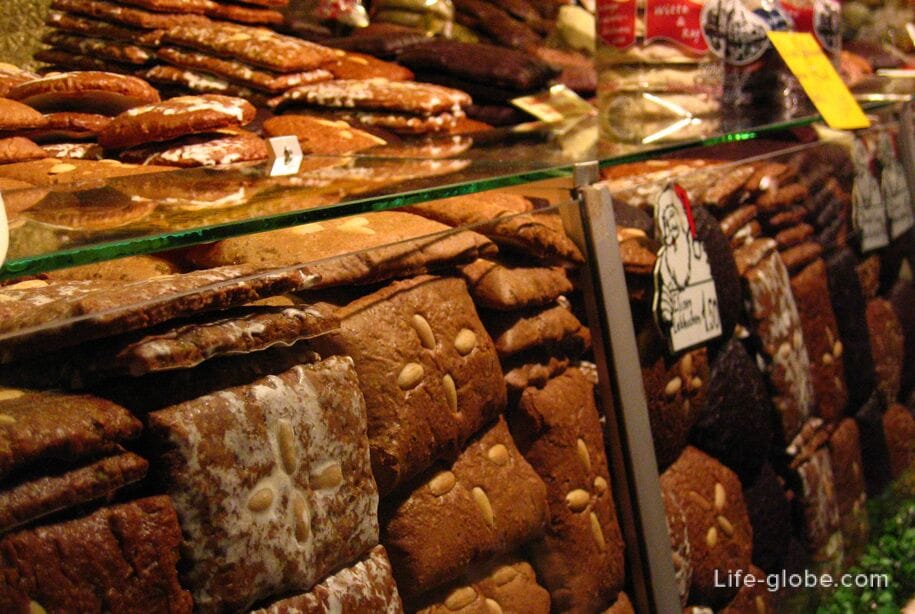
From the kiosks on the streets of the city, you can try various pastries.
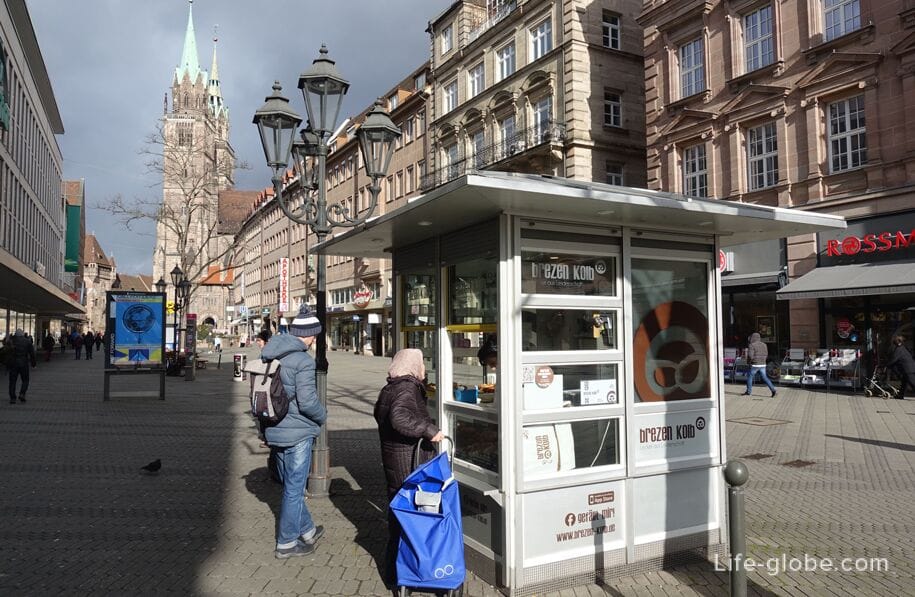
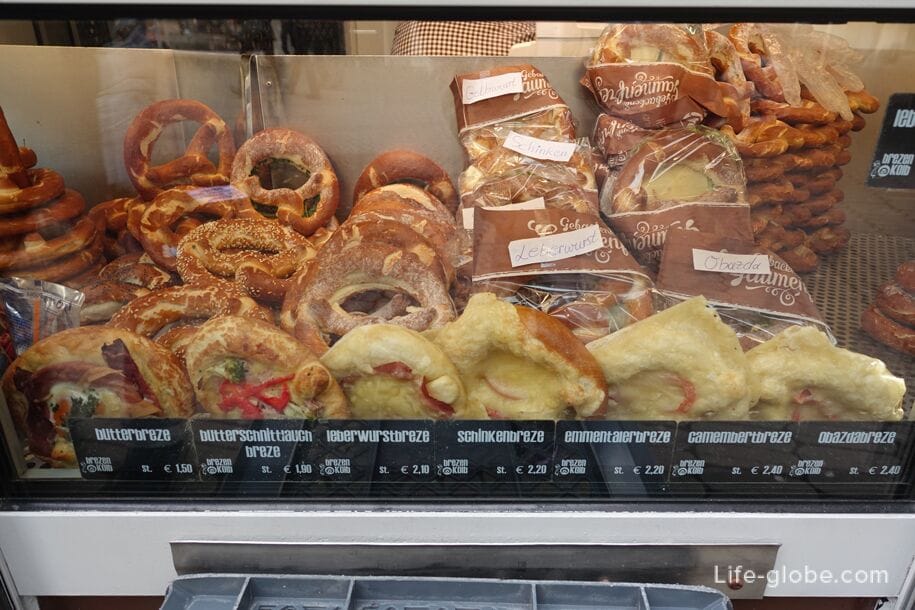
Among the drinks, this is the invariable Frankish beer, which is brewed both in the local breweries of Nuremberg and brought from all over the region.
Altstadthof and Schanzenbräu Brauerei breweries with summer beer gardens are well-known in the city.
Also among the restaurants with summer beer gardens can be distinguished: Finca & Bar Celona Nürnberg on the island of Schütt in the old town; Hexenhäusle with a view of the Nuremberg Fortress; Restauration Kopernikus - Restaurant & Biergarten at the former fortress wall of the old town; Cafe Wanderer & Bieramt; hotel and restaurant with beer garden Hotel & Weinrestaurant Steichele; Elke's Bierstadl im Kettensteg at the Chain Bridge; BALKON Nürnberg; Schnepperschütz - today a popular beer garden and cellar, and once a public toilet; Gasthaus Pegnitztal and Gutmann am Dutzendteich.
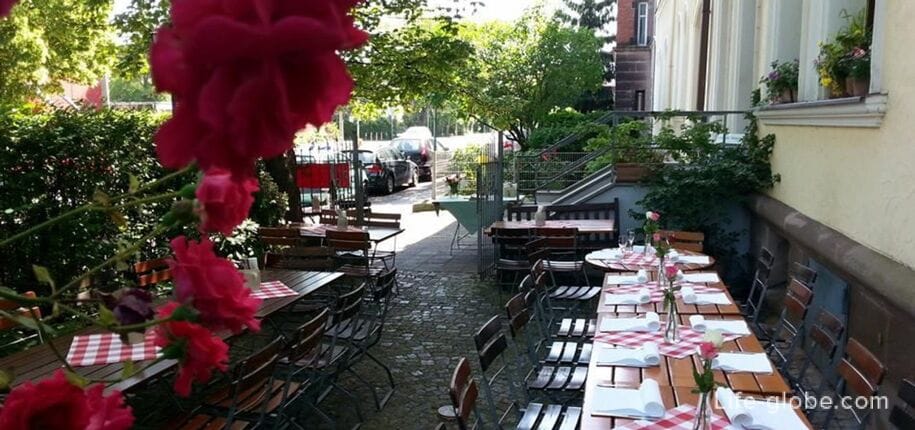
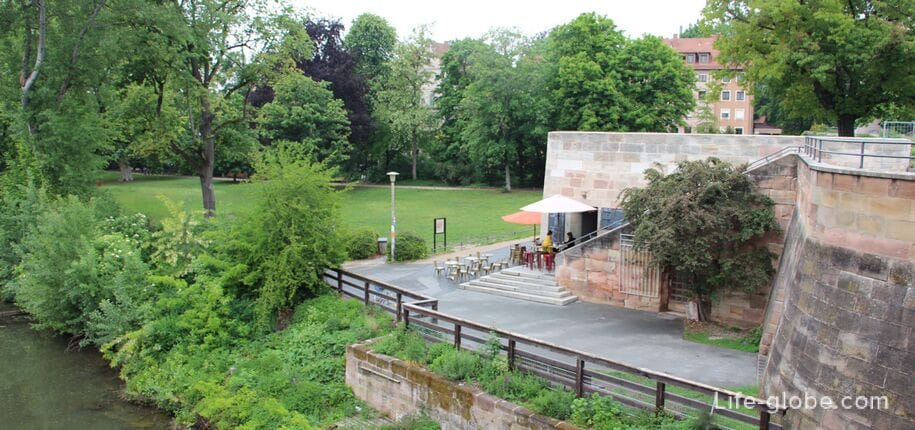
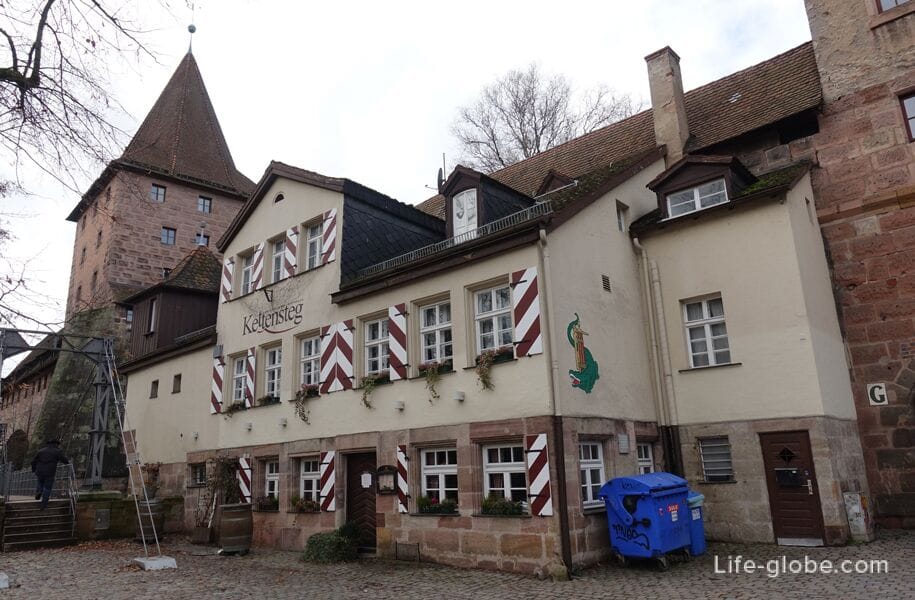
Franconian wine is also popular. The Franconian wine region is known for its white wines Silvaner, Bacchus and Riesling, as well as dry red wine Domina.
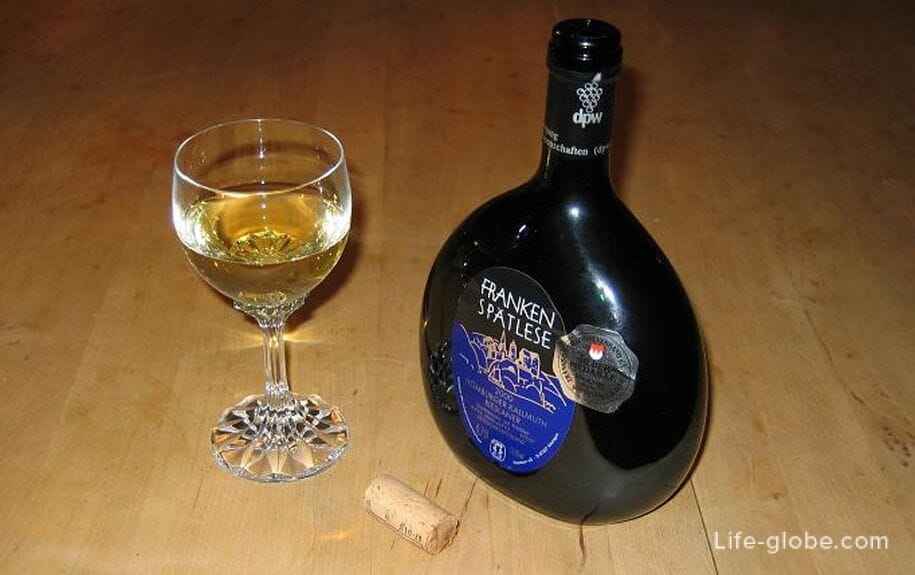
Where to go from Nuremberg
Near the city there is a water park Fürthermare Water Park, a theme park PLAYMOBIL®-Fun Park, golf courses.
From Nuremberg it is easy to drive around Franconia, there is a railway station and bus stations in the city, there is an international airport.
You can go to the beautiful town of Rothenburg ob der Tauber or the old city of Bamberg, which is famous not only for its historical center, but also for smoked beer and is known as the beer town of Franconia.
You can also recommend cities such as: Lauf an der Pegnitz, Ansbach, Dinkelsbuhl, Würzburg, Tauberbischofsheim, Weikersheim, Bayreuth and Ingolstadt.
It is most convenient to explore the surroundings of Nuremberg by car. You can pick up and book a car in Nuremberg here →
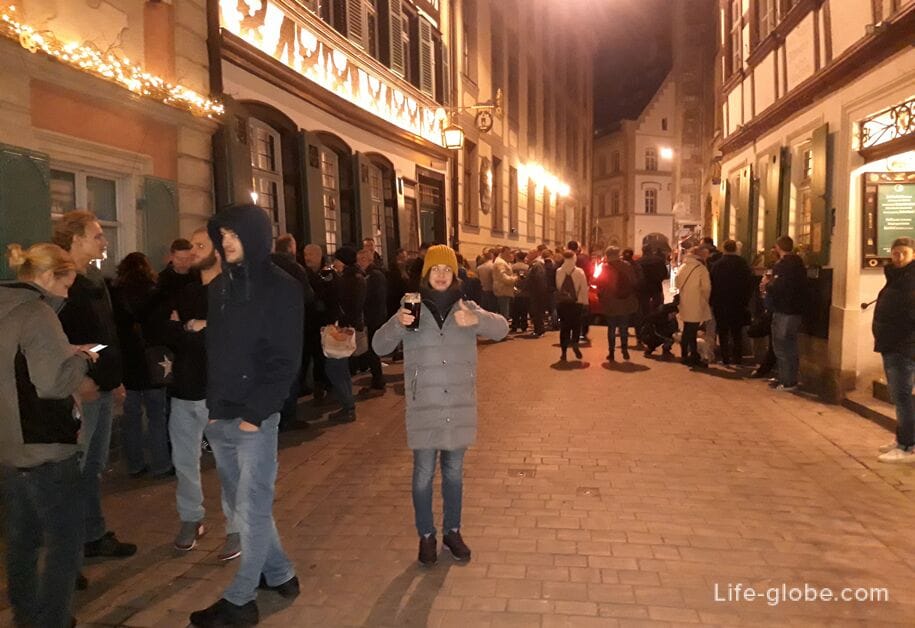
Excursions to and from Nuremberg
For the convenience of visiting the sights and museums of Nuremberg, you can purchase a Nuremberg card (NÜRNBERG CARD + FÜRTH) with which you can visit some museums and attractions for free. Free public transport is also included.
In Nuremberg, you can take a hop-on hop-off tour bus or a sightseeing train to the sights of the city.
You can view the cost and buy tourist maps, tour bus routes and buy tickets, as well as other excursions, tours and tickets in Nuremberg here →
Excursions in Nuremberg
Transport of Nuremberg
Of the public transport in Nuremberg, these are buses, trams and the metro. There is also a Nuremberg city train.
Website: vgn.de .
Where to stay in Nuremberg
The choice of accommodation facilities in Nuremberg is very diverse - starting from budget guest houses and apartments, ending with 5-star hotels located both in the historical center of the city and near the Pegnitz River, and more remotely from those.
All accommodation facilities in Nuremberg can be viewed and booked here
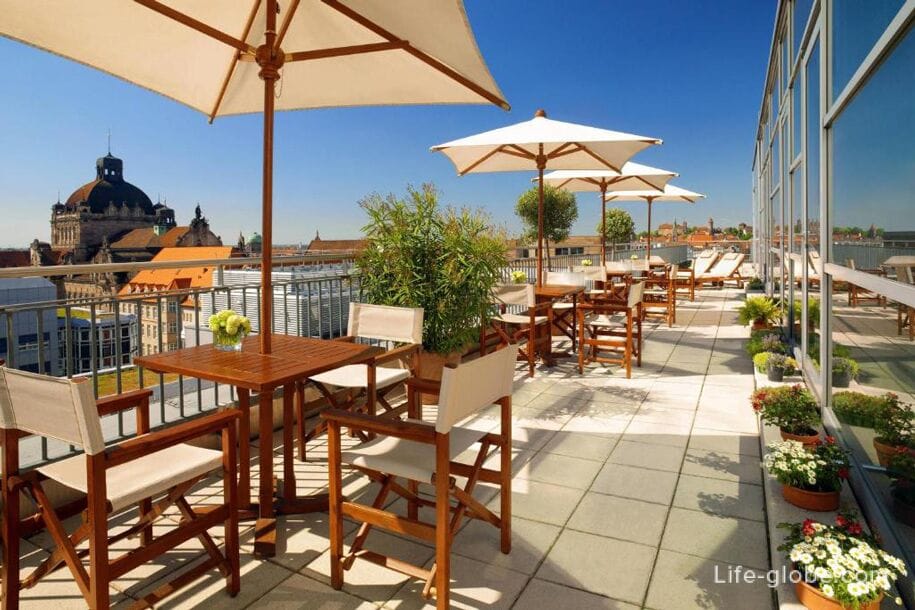
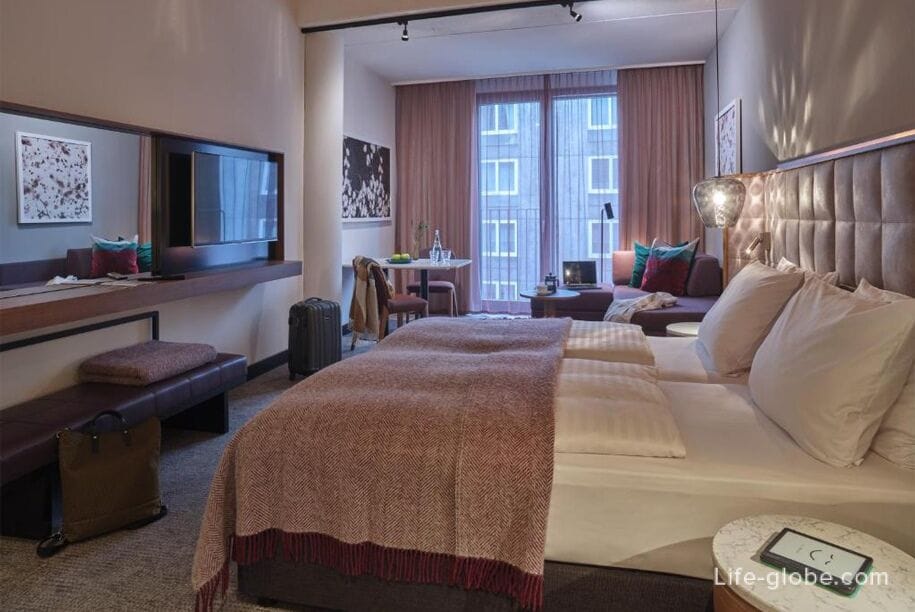
How to get to Nuremberg
The main tourist destination in the city is the international airport of Nuremberg named after Albrecht Dürer (Flughafen Nürnberg "Albrecht Dürer"), located in the city. Flights to Nuremberg →
You can get from the airport to the center of Nuremberg
- taxi/transfer. Getting from Nuremberg airport to the center of Nuremberg is most convenient and fastest by taxi. You can order a taxi / transfer in advance, even from home. At any time of the day, at the airport, a driver will be waiting for you with a sign where your first and last name will be written. To order a taxi, it is enough to provide your flight data!
- auto. The most convenient way to travel independently in Germany is by car. You can rent a car in advance, even from home, the car will be waiting for you immediately upon arrival. Cars for rent can be viewed and booked here →
- public transport. From public transport, these are metro and buses. Learn more about how to get from Nuremberg Airport to the city center...
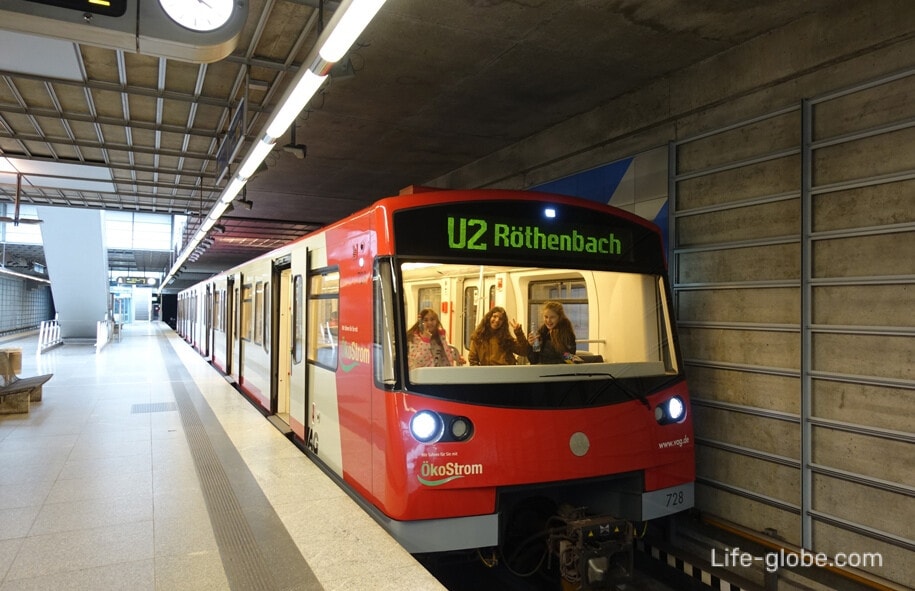
You can also arrive in Nuremberg by ship on the Main-Danube Canal (Main-Donau-Kanal Nürnberg).
You can get to Nuremberg from cities in Germany, as well as France, Italy, Austria, the Czech Republic, Hungary, Poland, Luxembourg, the Netherlands and some other European countries by bus. You can view all bus directions and buy a ticket here →
Trains run to Nuremberg (train and commuter train tickets →) and taxis (all taxis to Nuremberg →)
Currency and visas
Germany is part of the euro area. The currency of the country is Euro (€). Both cash and bank cards are accepted for payment in many shops, cafes and restaurants.
In some catering establishments (restaurants, pubs), to be able to pay with a bank card, an invoice amount of a certain amount is required - not infrequently from 20-40 euros.
Germany is part of the Schengen area. To visit the country, you may need travel insurance.
Nuremberg on the map
